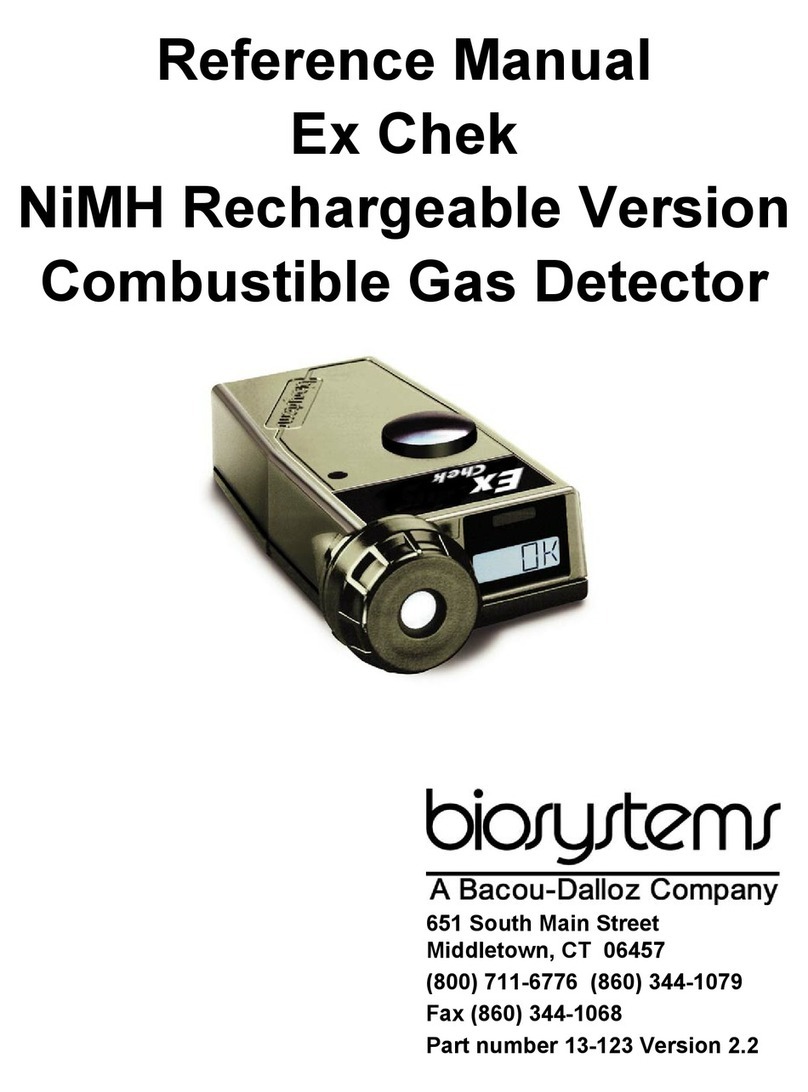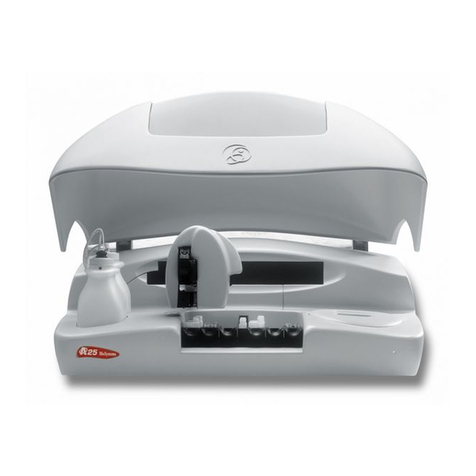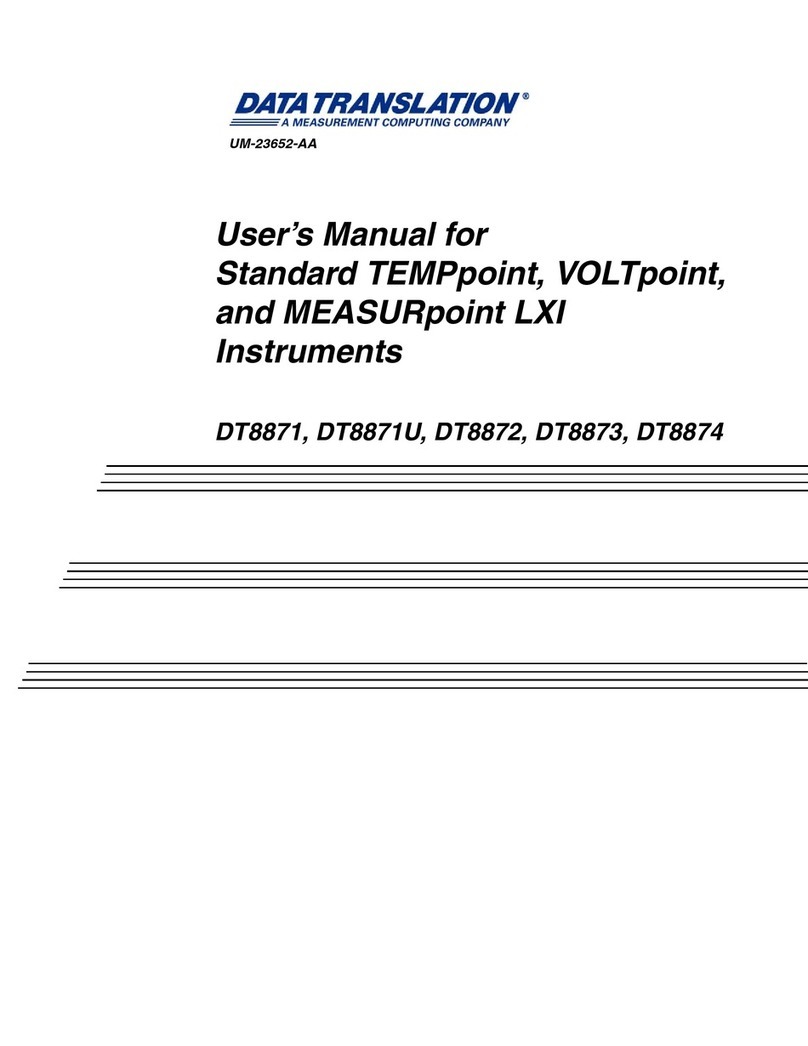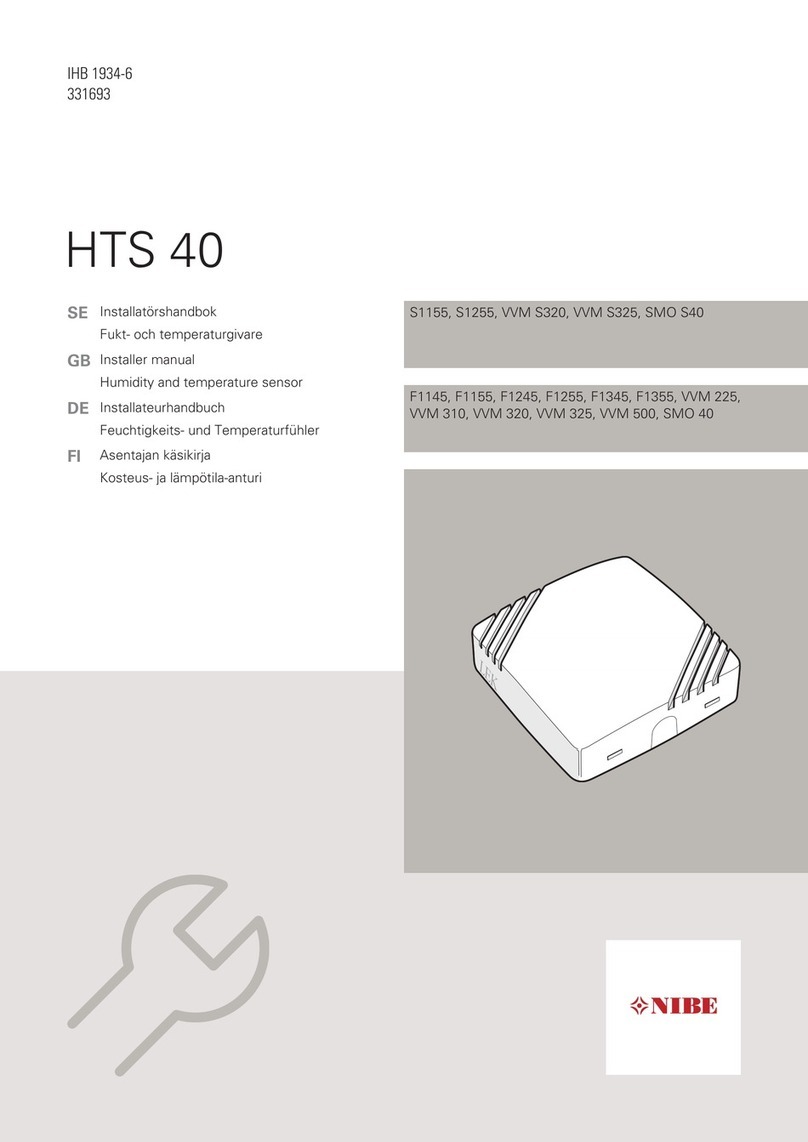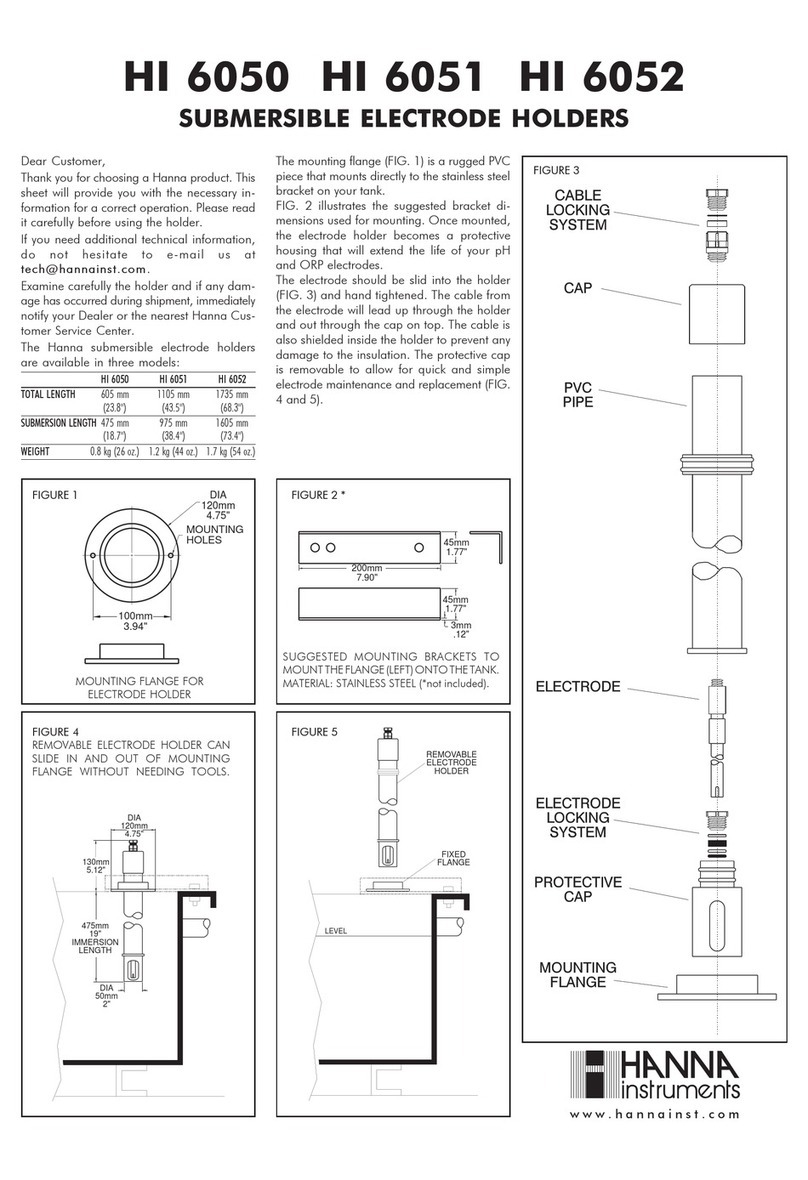biosystems ZoneGuard User manual

ZoneGuard
Single Channel Fixed Gas Detection System
Reference Manual
651 South Main Street
Middletown, CT 06457
Tel (860) 344-1079 (800) 711-6776
Fax (860) 344-1068
Version 2.3 30SEPT2005 p/n 13-063

Page 1
THE ZONEGUARD SINGLE CHANNEL FIXED GAS DETECTION SYSTEM HAS
BEEN DESIGNED FOR THE DETECTION AND MEASUREMENT OF
POTENTIALLY HAZARDOUS ATMOSPHERIC CONDITIONS
IN ORDER TO ASSURE THAT THE USER IS PROPERLY WARNED OF
POTENTIALLY DANGEROUS CONDITIONS, IT IS ESSENTIAL THAT THE
INSTRUCTIONS IN THIS MANUAL BE READ, FULLY UNDERSTOOD, AND
FOLLOWED.
ZoneGuard Operation Manual
Version 2.3
Part Number 13-063
Copyright 2005
by
Biosystems
651 South Main Street
Middletown, Connecticut 06457
All rights reserved.
No page or part of this operation manual may be reproduced in any form
without written permission of the copyright owner shown above.

Page 2
Table of Contents
SIGNAL WORDS .............................................................................................................4
WARNINGS......................................................................................................................4
CHAPTER 1. DESCRIPTION ........................................................................................5
1.1 ZONEGUARD CAPABILITIES ------------------------------------------------------------------------------------------------------5
1.2 METHOD OF SAMPLING -----------------------------------------------------------------------------------------------------------5
1.2.1 Wiring recommendations _________________________________________________________5
1.3 SENSOR OPTIONS -----------------------------------------------------------------------------------------------------------------5
1.4 CALIBRATION-----------------------------------------------------------------------------------------------------------------------5
1.4.1 One Button Auto Calibration_______________________________________________________5
1.5 DISPLAYS AND CONTROLS -------------------------------------------------------------------------------------------------------6
1.6 ALARM LOGIC----------------------------------------------------------------------------------------------------------------------6
1.7 SPECIAL MICROPROCESSOR FEATURES ---------------------------------------------------------------------------------------6
1.8 RELAYS AND OUTPUTS -----------------------------------------------------------------------------------------------------------6
1.8.1 VAC relay contacts______________________________________________________________6
1.8.2 VDC outputs___________________________________________________________________6
1.8.3 Output operation________________________________________________________________7
1.9 CLASSIFICATION FOR USE IN HAZARDOUS LOCATIONS-----------------------------------------------------------------------7
1.10 ZONEGUARD DESIGN COMPONENTS--------------------------------------------------------------------------------------------7
1.10.1 ZoneGuard controller ____________________________________________________________7
1.10.1.1 LED alarm light indicators......................................................................................................... 7
1.10.1.2 Audible alarm........................................................................................................................... 7
1.10.1.3 Detector display........................................................................................................................ 7
1.10.2 Remote detector assemblies ______________________________________________________7
1.10.2.1 Standard Detector housing ....................................................................................................... 7
1.10.2.2 Explosion-proof detector housing.............................................................................................. 7
CHAPTER 2. INSTALLATION AND BASIC OPERATION............................................8
2.1 INSTALLATION OVERVIEW --------------------------------------------------------------------------------------------------------8
2.2 ZONEGUARD CONTROLLER UNIT------------------------------------------------------------------------------------------------8
2.2.1 Controller PCBs ________________________________________________________________8
2.3 REMOTE DETECTOR ASSEMBLIES ----------------------------------------------------------------------------------------------8
2.3.1 Standard remote detector housing __________________________________________________8
2.3.2 Explosion-proof remote detector housing_____________________________________________8
2.4 SITING OF REMOTE DETECTORS ------------------------------------------------------------------------------------------------8
2.5 WIRING RECOMMENDATIONS ----------------------------------------------------------------------------------------------------9
2.5.1 Grounding_____________________________________________________________________9
2.6 CONNECTING REMOTE ALARM AND DETECTOR ASSEMBLIES WITH THE ZONEGUARD CONTROLLER -----------------9
2.6.1 Cautions______________________________________________________________________9
2.6.2 ZoneGuard controller connections __________________________________________________9
2.7 INITIAL SETUP----------------------------------------------------------------------------------------------------------------------9
2.8 NORMAL OPERATION--------------------------------------------------------------------------------------------------------------10
2.8.1 Overview of ZoneGuard operation __________________________________________________10
2.8.2 Turning the ZoneGuard on ________________________________________________________10
2.8.3 Turning the ZoneGuard off ________________________________________________________10
2.8.4 Start-up sequence ______________________________________________________________10
2.9 OPERATING MODES ---------------------------------------------------------------------------------------------------------------10
2.9.1 Text Only mode ________________________________________________________________10
2.9.2 Basic mode ___________________________________________________________________11
2.9.3 Changing operating modes________________________________________________________11
2.10 ENABLING OR DISABLING USE OF THE MODE BUTTON-----------------------------------------------------------------------11
CHAPTER 3 CALIBRATION.........................................................................................11
3.1 WARNINGS AND CAUTIONS CONCERNING VERIFICATION OF ACCURACY---------------------------------------------------11

Page 3
3.2 CALIBRATION OVERVIEW ---------------------------------------------------------------------------------------------------------11
3.3 VERIFICATION OF ACCURACY ----------------------------------------------------------------------------------------------------11
3.3.1 Fresh air "zero" in contaminated air _________________________________________________12
3.4 EFFECT OF CONTAMINANTS ON ZONEGUARD SENSORS --------------------------------------------------------------------12
3.4.1 Effects of contaminants on oxygen sensors ___________________________________________12
3.4.2 Effects of contaminants on combustible sensors _______________________________________12
3.4.2.1 Effects of high concentrations of combustible gas on the combustible sensor...........................12
3.4.3 Effects of contaminants on toxic gas sensors__________________________________________13
3.5 FUNCTIONAL (BUMP)TEST-------------------------------------------------------------------------------------------------------13
3.6 AUTO-CALIBRATION ---------------------------------------------------------------------------------------------------------------13
3.6.1 Fresh air "zero" auto-calibration sequence____________________________________________14
3.6.1.1 Reading “Too High” or “Too Low” for zero adjust......................................................................14
3.6.2 “Span” auto-calibration sequence___________________________________________________14
3.7 MANUAL CALIBRATION PROCEDURE --------------------------------------------------------------------------------------------15
3.7.1 Manual Fresh air "zero" through keypad buttons _______________________________________15
3.7.2 “Manual” span calibration through keypad buttons ______________________________________15
3.7.3 Manual true zero span calibration for oxygen sensors ___________________________________16
CHAPTER 4. SETTING ALARM LEVELS.....................................................................17
4.1 ALARM ADJUSTMENT SEQUENCE -----------------------------------------------------------------------------------------------17
4.2 RESTORING THE FACTORY DEFAULT ALARM SETTINGS ---------------------------------------------------------------------18
4.3 ALARM TEST FUNCTION ----------------------------------------------------------------------------------------------------------18
CHAPTER 5. ADVANCED FUNCTIONS.......................................................................19
5.1 ZONEGUARD ADVANCED FEATURES OVERVIEW------------------------------------------------------------------------------19
5.2 RE-SETTING THE CALIBRATION GAS CONCENTRATION ----------------------------------------------------------------------19
APPENDICES...................................................................................................................20
APPENDIX AZONEGUARD FIXED GAS DETECTION SYSTEM ORDERING INFORMATION----------------------------------------20
APPENDIX BZONEGUARD FIXED GAS DETECTION SYSTEM TECHNICAL SPECIFICATIONS------------------------------------21
APPENDIX CZONEGUARD DEFAULT ALARM SETTINGS ---------------------------------------------------------------------------22
APPENDIX DZONEGUARD SENSOR RANGES ---------------------------------------------------------------------------------------22
APPENDIX EZONEGUARD TOXIC SENSOR CROSS SENSITIVITY DATA-----------------------------------------------------------22
APPENDIX FZONEGUARD DIMENSIONAL DRAWINGS,ELECTRICAL SCHEMATICS,AND WIRING DIAGRAMS ----------------23
APPENDIX GCALIBRATION FREQUENCY --------------------------------------------------------------------------------------------26
BIOSYSTEMS STANDARD WARRANTY GAS DETECTION PRODUCTS....................27

Page 4
SIGNAL WORDS
The following signal words, as defined by ANSI Z535.4-1998, are used in the Zoneguard Reference Manual.
indicates an imminently hazardous situation which, if not avoided, will result in
death or serious injury.
indicates a potentially hazardous situation which, if not avoided, could result in
death or serious injury.
indicates a potentially hazardous situation, which if not avoided, may result in
moderate or minor injury.
CAUTION used without the safety alert symbol indicates a potentially hazardous situation which, if
not avoided, may result in property damage.
WARNINGS
1. The Zoneguard personal, portable gas detector has been designed for the detection of
dangerous atmospheric conditions. An alarm condition indicates the presence of a potentially life-threatening
hazard and should be taken very seriously. Failure to immediately leave the area during an alarm condition may
result in serious injury or death.
2. In the event of an alarm condition it is important to follow established procedures. The safest
course of action is to immediately leave the affected area, and to return only after further testing determines that the
area is once again safe for entry. Failure to immediately leave the area during an alarm condition may result in
serious injury or death.
3. The accuracy of the Zoneguard should be checked periodically with known concentration
calibration gas. Failure to check accuracy can lead to inaccurate and potentially dangerous readings.
4. The accuracy of the Zoneguard should be checked immediately following any known exposure
to contaminants by testing with known concentration test gas before further use. Failure to check accuracy can
lead to inaccurate and potentially dangerous readings.
5. A sensor that cannot be calibrated or is found to be out of tolerance should be replaced
immediately. An instrument that fails calibration may not be used until testing with known concentration test gas
determines that accuracy has been restored, and the instrument is once again fit for use.
6. Do not reset the calibration gas concentration unless you are using a calibration gas
concentration that differs from the one that is normally supplied by Biosystems for use in calibrating the
Zoneguard. Use of inappropriate calibration gas may lead to in accurate and potentially dangerous readings.
Customers are strongly urged to use only Biosystems calibration materials when calibrating the Zoneguard. Use of
non-standard calibration gas and/or calibration kit components can lead to dangerously inaccurate readings and
may void the standard Biosystems warranty.
7. Use of non-standard calibration gas and/or calibration kit components when calibrating the
Zoneguard can lead to inaccurate and potentially dangerous readings and may void the standard Biosystems
warranty.
Biosystems offers calibration kits and long-lasting cylinders of test gas specifically developed for easy Zoneguard
calibration. Customers are strongly urged to use only Biosystems calibration materials when calibrating the
Zoneguard.
8. Substitution of components may impair intrinsic safety.
9. For safety reasons this equipment must be operated and serviced by qualified personnel only.
Read and understand this reference manual before operating or servicing the Zoneguard.
10. A rapid up-scale reading followed by a declining or erratic reading may indicate a hazardous
combustible gas concentration that exceeds the Zoneguard’s zero to 100 percent LEL detectionrange. The safest
course of action is to immediately leave the affected area, and to return only after further testing determines that the
area is once again safe for entry.

Page 5
CHAPTER 1. DESCRIPTION
1.1 ZoneGuard capabilities
The ZoneGuard is a microprocessor based fixed gas
detection system designed to accept the input from a single
oxygen, combustible gas or toxic sensor. ZoneGuard
systems are designed to provide continuous round-the-clock
monitoring for a variety of common atmospheric hazards
including oxygen deficiency and/or enrichment, combustible
gases and vapors, and specific toxic contaminants such as
carbon monoxide (CO), hydrogen sulfide (H2S), sulfur
dioxide (SO2), chlorine (Cl2), chlorine dioxide (ClO2),
phosphine (PH3), and nitrogen dioxide (NO2). Sensors may
be integrally mounted to the ZoneGuard controller housing,
or located up to 50 feet away from the controller. Remote
detector assemblies are available in explosion-proof or non-
explosion-proof versions. (Combustible sensors may only
be mounted in explosion-proof sensor housings.) The unit is
designed for operation via 120VAC 60 Hz. external power
source.
Standard features include two independently adjustable
alarm setpoints, built-in loud audible alarm (85 dB at 3-feet),
easily-read, backlit LCD display, and bright LED alarm light
indicators for OK / power on (green), low alarm (amber) and
high alarm (red) conditions. Standard features also include
DPDT relay contacts (rated 5A at 250V non-inductive load)
for low and high alarm conditions. Optional accessories
include externally mounted high intensity strobe lights and
high intensity horn.
The ZoneGuard offers a choice of two modes of operation,
Text Only (“OK”), and Basic (numeric readings) to provide
the right amount of information for users with different skill
levels and monitoring requirements. Biosystems’ “One
Button” operating logic allows all procedures necessary for
normal day-to-day operation, including fully automatic
calibration adjustment, to be made through the use of the
single On/Off “Mode” button.
ZoneGuard sensors which are installed in explosion-proof
remote detector housings are classified by Underwriters
Laboratories, Inc. and the Canadian Standards Association
as Explosion-Proof for use in Class I, Division 1, Groups A,
B, C, D, E, F and G hazardous locations.
Each ZoneGuard system includes the controller with all
standard alarms, relays and electronics installed in a NEMA
4X fiberglass housing; sensor, mounting ears, calibration
adaptor, Reference Manual, Quick Reference Card, and
other standard accessories. Remote detector assemblies
include the remote sensor housing, the appropriate amplifier
board (installed in the remote detector housing), and sensor.
Note: Conduit, wire and other components necessary
to connect the remote detector assembly with the
instrument controller are not included and must be
ordered separately.
The ZoneGuard design includes many user selectable
features and is designed to be easily customized to meet
specific customer requirements. This chapter discusses
some of these special features as well as basic capabilities
used on a day-to-day basis.
1.2 Method of sampling
Once it has been connected to a power source and placed
in normal operation, the ZoneGuard system continuously
monitors for the hazard the sensor is designed to detect.
ZoneGuard sensors may be either integrally mounted to the
controller housing, or remotely located up to 50 feet away
from the controller. The atmosphere being measured
reaches the sensor by diffusing through a protective filter
into the sensor. Normal air movements are enough to carry
the sample to the sensor. The sensor reacts to changes in
the concentration of the hazard being measured. Values
are constantly updated and displayed on the ZoneGuard
controller LCD.
1.2.1 Wiring recommendations
For oxygen remote detectors use (minimum) 22 gauge
AWG, 6 conductor twisted-pair shielded with drain. For toxic
remote detectors use (minimum) 22 gauge AWG, 4
conductor twisted-pair shielded with drain. For combustible
remote detectors use 18 gauge AWG, 4 conductor twisted-
pair shielded with drain.
The maximum distance a ZoneGuard remote detector may
be located from the controller is 50 feet.
1.3 Sensor options
ZoneGuard systems can be configured to monitor for a
number of different atmospheric hazards. The hazard the
system is configured to detect is determined by the type of
sensor installed. The types of sensors currently available
include a galvanic oxygen (O2) sensor, a catalytic-bead
pellistor for LEL combustible gas, and substance-specific
electrochemical sensors for carbon monoxide (CO),
hydrogen sulfide (H2S), sulfur dioxide (SO2), chlorine (Cl2),
chlorine dioxide (ClO2), phosphine (PH3), and nitrogen
dioxide (NO2). Oxygen readings are given in percent-by-
volume, combustible gas readings in percent LEL, and toxic
gas readings in PPM (parts per million) or 0.1 PPM
concentrations.
1.4 Calibration
ZoneGuard systems have been designed for easy
verification of accuracy.
The accuracy of the Zoneguard
should be checked periodically with known
concentration calibration gas. Failure to check
accuracy can lead to inaccurate and potentially
dangerous readings.
1.4.1 One Button Auto Calibration
Biosystems’ “One Button” logic means that all normal day-
to-day operating procedures, including automatic calibration
adjustment, may be made through the use of the single
On/Off Mode button.
Calibration procedures are discussed in detail in
Chapter 3.

Page 6
1.5 Displays and controls
ZoneGuard systems include an 8-character LCD readout
located at the controller which is used to display gas
readings and other messages. Built-in LED alarm lights are
used to indicate “OK” / Power-on (green), “Low Alarm”
(amber), and “High Alarm” (red) conditions.
The On/Off “Mode” button is to initiate the automatic
calibration sequence and to control most other day-to-day
procedures. The button is located on the exterior of the
controller housing, on the underside of the case. Four
additional push-button controls (“-”, “+”, “Alarm” and “Cal”)
are located on the inside of the controller housing door.
These buttons are used for advanced procedures such as
changing operating modes, changing alarm setpoints,
adjusting calibration gas values, making optional setup
choices, and other advanced procedures.
1.6 Alarm Logic
The Zoneguard personal, portable
gas detector has been designed for the detection of
dangerous atmospheric conditions. An alarm condition
indicates the presence of a potentially life-threatening
hazard and should be taken very seriously. Failure to
immediately leave the area during an alarm condition
may result in serious injury or death.
In the event of an alarm condition it is important to
follow established procedures. The safest course of
action is to immediately leave the affected area, and
return only after further testing together with other
appropriate safety procedures determine that the area
is once again safe for entry.
ZoneGuard alarms are user adjustable and may be set
anywhere within the range of the specific sensor. When an
alarm set point is exceeded the audible alarm sounds, the
appropriate bright LED alarm light indicator are turned-on,
and (if equipped) the optional external strobe light(s) and/or
remote high intensity audible alarm are activated. (Any
external alarm devices controlled by means of the
ZoneGuard alarm relay contacts will also be activated.)
ZoneGuard alarms are normally of the self-resetting type.
When readings drop back below the pre-set alarm levels,
the instrument returns to normal operation, and the visual
and audible alarms cease.
It is possible to set ZoneGuard alarms so that they "latch".
In the latched condition, once an alarm occurs both visual
and audible alarms will continue to sound even after the
atmospheric hazard has cleared. The instrument must be
manually reset before the alarms are silenced.
Procedures for latching ZoneGuard alarms are given in
Chapter 4.
ZoneGuard systems equipped with toxic or combustible gas
sensors are provided with two levels of gas alarm: “Low”
(warning) and “High” (danger). Toxic and combustible
alarms are configured as “ascending”, meaning that they are
triggered when gas concentrations exceed the alarm
setpoints.
ZoneGuard systems equipped with oxygen sensors have
four levels of gas alarm, two “ascending” alarms (“Warning”
and “Danger”) for oxygen enrichment, and two “descending”
(“Warning” and “Danger”) alarms for oxygen deficiencies.
Descending alarms are activated when oxygen
concentrations drop below the alarm setpoints for oxygen
deficiency.
Note: “Warning” level alarms may be manually
acknowledged and silenced for a period of 10 minutes
by pressing the Mode button. If the alarm condition
continues to exist after 10 minutes has elapsed, the
“Warning” alarms will be reactivated. If the alarm
condition reaches the “Danger” level during this 10
minute period, the “Danger” level alarms will
immediately be activated regardless of whether or not
the “Warning” alarm has been silenced. “Danger” level
alarms may not be manually silenced.
The procedures for adjusting alarm setpoints are given
in Chapter 4.
1.7 Special microprocessor features
Several automatic programs prevent tampering and misuse
of the ZoneGuard by unauthorized persons. Each time the
detector is turned on, an electronic self-test is performed
that assures the user of proper performance.
Optional setup choices include latching alarms, changing the
concentration of the gas that is used during Auto Calibration
adjustment, as well as changing or restoring the factory
alarm settings by using the 4 push-buttons on the instrument
keypad. It is also possible to enable or disable use of the
external Mode button.
ZoneGuard software also includes an “Alarm Test” function
that can be used to automatically “ramp” readings
throughout the full range of the sensor. The “Alarm Test”
function is used to verify alarm setpoints as well as the
proper activation of the audible alarm, LED alarm light
indicators, optional strobe lights or horn, as well as other
alarm devices or peripheral equipment controlled by means
of the ZoneGuard relay contacts.
Chapters 4 and 5 describe how to use these advanced
technical features and setup choices in greater detail.
1.8 Relays and outputs
See Appendix F for ZoneGuard electrical schematics
and wiring diagrams.
1.8.1 VAC relay contacts
ZoneGuard systems include DPDT relay contacts for
warning (low) and danger (high) gas alarm conditions.
ZoneGuard relay contacts are rated at 5 Amp at 250 VAC,
non-inductive load.
1.8.2 VDC outputs
ZoneGuard systems also include +12 VDC outputs rated at
0.5 Amp for warning (low) and danger (high) gas alarm
conditions.

Page 7
CAUTION: ZoneGuard +12 VDC outputs may only be
used to provide power to remote alarm devices which
have been approved by Biosystems for use with the
ZoneGuard system. Use of non-approved devices may
cause damage to the ZoneGuard system, and void the
Biosystems Standard Warranty for Gas Detection
Products. Contact Biosystems Technical Service
Department at (860) 344-1079 for additional information
on approved remote alarm devices.
1.8.3 Output operation
ZoneGuard alarms are normally of the “self-resetting” type,
and will cease when readings drop back below the pre-set
alarm levels. ZoneGuard alarms may also be configured to
“latch” so that the alarms remain activated even after the
alarm condition has ceased. Once activated, a latched
alarm will continue to sound until the instrument is manually
reset by pressing the mode button.
The procedure for changing the alarm latch setting is
given in Chapter 4
If the gas concentration causes the activation of the low
(warning level) alarm, the audible alarm is activated, the low
level (amber) alarm LED illuminates, and the low alarm relay
is activated. Warning level alarms may be silenced and the
relay deactivated for a period of 10 minutes by pressing the
Mode button.
If the gas concentration causes the activation of the high
(danger level) alarm, the audible alarm is activated, the high
level (red) alarm LED illuminates, and the high alarm relay is
activated. High level alarms may not be manually silenced
by pressing the Mode button.
ZoneGuard systems are supplied with relays and outputs
preset with the following standard factory setup:
VAC relays:
Warning (low) alarm Normally energized (fail safe)
Danger (high) alarm Normally energized (fail safe)
12 VDC outputs:
Warning (low) alarm Normally de-energized
Danger (high) alarm Normally de-energized
1.9 Classification for use in hazardous
locations
ZoneGuard remote detector assemblies are available in
both explosion-proof and non-explosion-proof versions.
Explosion-proof version remote detector assemblies have
been submitted to Underwriters Laboratories, Inc. for
Classification per ULCas Explosion-Proof for use in Class I,
Division 1, Groups A, B, C, D, E, F, and G explosive
atmospheres.
1.10 ZoneGuard design components
See Appendix F for dimensional drawings, mounting
schematics, and wiring diagrams for the ZoneGuard
controller and remote detector assemblies.
1.10.1 ZoneGuard controller
The ZoneGuard controller unit is enclosed in a durable,
gasketed, fiberglass NEMA 4X case. The On/Off Mode
button is located on the exterior of the controller housing, on
the underside of the case. Four additional push-button
controls (“-”, “+”, “Alarm” and “Cal”) are located inside the
door of the controller housing.
1.10.1.1 LED alarm light indicators
ZoneGuard controllers include 3 bright system status and
alarm condition LED indicators; green for “OK” / Power On,
amber for “Warning”, and red for “Danger”.
1.10.1.2 Audible alarm
A loud (85 dB at 3 feet) built-in audible alarm is provided to
warn users of hazardous conditions. Optional remote
audible alarms and high intensity horns are also available.
1.10.1.3 Detector display
An 8-character LCD readout is used to display gas readings
and other information.
Readings, messages, and modes of operation are
discussed in Chapter 2.
1.10.2 Remote detector assemblies
Remote detector assemblies include sensor, sensor specific
amplifier board (installed in the remote detector housing),
and remote detector housing. Oxygen and toxic gas remote
detector assemblies are available in both “standard” (non-
explosion-proof) and “explosion-proof” versions. Remote
detector assemblies for combustible gas are only available
in explosion-proof housings.
Installation procedures are discussed in Chapter 2.
1.10.2.1 Standard Detector housing
“Standard” remote detector assemblies are housed in a
heavy-duty, nickel-coated, molded junction box. Not for use
in hazardous locations.
1.10.2.2 Explosion-proof detector housing
“Explosion-proof” remote detector assemblies are housed in
a heavy duty steel explosion-proof (Class I, Division 1,
Groups A, B, C, D, E, F, G) junction box with threaded lid.

Page 8
CHAPTER 2. INSTALLATION AND
BASIC OPERATION
2.1 Installation overview
Biosystems gas detection systems are fully tested and
calibrated before they leave the factory. However, after
installation we strongly recommend that full testing and
verification of proper operation is carried out before the
system is placed in normal service. Make sure all
ZoneGuard system elements and/or peripheral alarm,
notification, or control devices are properly installed
before connecting the system to a power source!
Make sure that the ZoneGuard system is disconnected
from the external power source before installing,
replacing, or handling ZoneGuard system components!
Repair of system components damaged as a result of
improper installation can be expensive! ZoneGuard
installation, initial setup, and / or system modification
should only be undertaken by individuals who are
qualified and authorized to do so. Call Biosystems’
Service Department at (860) 344-1079 if you need help
or have any questions.
2.2 ZoneGuard controller unit
The ZoneGuard controller unit is designed for wall mounting
in any convenient non-hazardous location where a suitable
power supply is available. ZoneGuard controller units are
designed for use with 120VAC, 60Hz. external power.
Note: ZoneGuard controller housing accessories
include a set of 4 external mounting brackets. Use of
these mounting brackets is optional. The controller
housing may be mounted directly to the wall or other
mounting surface by use of screws inserted through
apertures in 4 mounting wells located on the back of the
controller case, or by means of the external mounting
brackets, whichever is more convenient.
ZoneGuard controller housing accessories also include a ½”
NPT galvanized cable grab “gland”. If the cable connecting
the remote detector housing with the controller is run through
conduit, it will be necessary to remove the cable grab gland
and replace it with a threaded ½” NPT conduit bushing (not
provided). When making use of ZoneGuard relay contacts
to control or actuate external alarm devices it will be
necessary to remove the “hole-seal” from the bottom of the
controller case, and install the appropriate glands or
bushings. To prevent dust and water ingress all cable
entries and knockouts must be checked and sealed as
necessary.
2.2.1 Controller PCBs
The ZoneGuard controller includes a display PCB located
underneath the hinged controller case cover, and the relay
PCB located on a mounting plate inside the controller case.
In the case of ZoneGuard systems with integrally mounted
sensors, a sensor specific amplifier board is mounted onto
the relay PCB. In the case of ZoneGuard systems with
remote sensors, the amplifier board is located in the remote
detector housing.
The four push-buttons (“+”,“-”, “Alarm”, and “Cal”) used to
make use of advanced features and setup choices are
located on the display PCB on the inside of the controller
housing door.
2.3 Remote detector assemblies
Oxygen and toxic gas remote detector assemblies are
available in both “standard” (non-explosion-proof) and
“explosion-proof” housings. Remote detector assemblies for
combustible gas are only available in explosion-proof
housings.
ZoneGuard remote detector assemblies may be located up
to 50 feet away from the controller. Power is provided to
the remote detector by the ZoneGuard controller.
The ZoneGuard remote detector assembly contains a
factory installed, sensor specific amplifier PCB. The remote
detector assembly is labeled as to the type of hazard it is
designed to measure (i.e. H2S, CO, O2, etc.).
2.3.1 Standard remote detector housing
Sensors for the measurement of oxygen and toxic gas may
be installed either in explosion-proof or “standard” remote
detector housings.
Sensors that are housed in
“standard” remote detector housings may not be
installed in hazardous locations requiring an
“Explosion-Proof” classification.
2.3.2 Explosion-proof remote detector
housing
Explosion-proof remote detector housings can be installed in
Class I, Division 1 Groups A through G hazardous locations.
Explosion-proof remote detectors are installed in a heavy
duty stainless steel explosion-proof (Class I, Division 1,
Groups A through G) junction box with threaded lid.
ZoneGuard sensors for the measurement of
combustible gas may only be installed in explosion-
proof remote detector housings.
2.4 Siting of remote detectors
The specific placement of remote detector assemblies
should be a function of the type of area being monitored, the
type and source of atmospheric hazard being measured,
prevailing wind patterns, and other information.
Call Biosystems Technical Service Department at (860)
344-1079 for additional advice.
In general, for gases lighter than air, the detector should be
placed at a level slightly above the area where leaks are
likely to occur. For gases which are heavier than air the
detectors should be located close to floor level or in
inspection pits or ducts into which heavier than air gases
may collect or flow.
There are many circumstances which may modify this
general advice. For example, the molecular weight of
nitrogen (MW ≅28) is very close to that of air (MW ≅29).

Page 9
When nitrogen is at the same temperature as the air into
which it is introduced, it mixes readily, and tends to spread
evenly through the affected atmosphere. On the other hand,
if the nitrogen is under pressure, and then suddenly released
into the atmosphere, as the gas expands (going from higher
pressure to a lower pressure) it cools. Because the cooler
gas is now denser than the air into which it is being
introduced, it no longer mixes in as readily. Instead, the
nitrogen tends to fall to floor level, then spread laterally. In
this case remote detectors being used to monitor for oxygen
deficiency should be located near floor level in order to
detect the deficiency as quickly as possible.
The nearer in density to air a gas is, the more easily it will
flow with air due to draughts, ventilation etc. A compromise
approach for placement of detectors used to measure
gases which are only slighter lighter (such as carbon
monoxide) or heavier (such as hydrogen sulfide) than air is
to mount the detectors at a height as close as possible to
the breathing area of personnel being protected.
When installing detector assemblies it is important to ensure
that the sensor is not exposed to liquid or dust contamination
which would interfere with the passage of gas through the
protective filter into the sensor. Remote detector
assemblies should be placed so that the axis of the sensor
points straight downward. Splash deflectors should be used
when water or other liquid is chronically present in the area
where the detectors have been located.
2.5 Wiring recommendations
For oxygen remote detectors use (minimum) 22 gauge
AWG, 6 conductor twisted-pair shielded with drain. For toxic
remote detectors use (minimum) 22 gauge AWG, 4
conductor twisted-pair shielded with drain. For combustible
remote detectors use 18 gauge AWG, 4 conductor twisted-
pair shielded with drain.
The maximum distance a ZoneGuard remote detector may
be located from the controller is 50 feet.
Due to the relatively low signal levels carried by wiring
between gas detectors and their control unit, it is essential
not to run wire near high power electrical equipment. When
ZoneGuard systems are installed in environments which
contain high power electrical equipment it is usually best to
install the wire in conduit.
2.5.1 Grounding
Wire used to connect ZoneGuard remote detector
assemblies with the controller should always be with drain
lead. In order to reduce the chances for electromagnetic
interference (EMI), the screen (drain) of the wire should be
connected to the ground plate of the detector head (long
reach glands and/or the screen terminals should be used for
this purpose). Ground loops must be avoided! Grounding is
done through the normal circuit ground of the system.
2.6 Connecting remote alarm and
detector assemblies with the
ZoneGuard controller
2.6.1 Cautions
CAUTION: Make sure that the ZoneGuard system is
disconnected from the external power source before
installing, replacing, or handling installed ZoneGuard
system components!
CAUTION: Make sure the remote detector housing is
properly connected to the correct controller terminal
block connector as discussed below.
CAUTION: +12 VDC outputs may only be used to
provide power to remote alarm devices which have
been approved by Biosystems for use with the
ZoneGuard system. Use of non-approved devices may
cause damage to the ZoneGuard system, and void the
Biosystems Standard Warranty for Gas Detection
Products. Contact Biosystems Technical Service
Department at (860) 344-1079 for additional information
on approved remote alarm devices.
2.6.2 ZoneGuard controller connections
Electrical connections and wiring diagrams for the
ZoneGuard controller are shown in Appendix F.
Full wiring schematics are available on the Biosystems
website or by contacting Biosystems directly.
Connections are by screw terminal blocks located on the
mounting plate and relay PCB located in the ZoneGuard
controller. Warning (Low) and Danger (High) VAC output
relays are DPDT, are isolated from the system power
supply, and are rated at 5 Amp, 250VAC, non-inductive.
Warning (Low) and Danger (High) VDC outputs (+12 VDC
at 0.5 Amp) may only be used to provide power to remote
alarm devices which have been approved by Biosystems for
use with ZoneGuard systems.
2.7 Initial setup
1. Make sure the controller is not connected to any other
peripheral or external equipment or alarm devices.
2. Disconnect the built-in “loud” 85 dB audible alarm.
3. Make sure any other alarm or notification devices
controlled by means of the ZoneGuard relay contacts
are disconnected or turned off.
4. Connect mains power to the controller.
5. Connecting the ZoneGuard system with mains power
will cause the detector to turn on in normal operation.
The green “OK / Power On” LED indicator should be lit
and the LCD display should be on. The LCD display
should show a sequence of start-up screens as the
detector goes through a self test sequence, followed by
the current gas level readings. The low or high LED
alarm indicators, optional strobe lights, remote audible
alarms, and other devices connected to may be
activated while the sensor is stabilizing.

Page 10
Note: The ZoneGuard system is designed so that in
the event of a power interruption, the instrument will
automatically turn itself back on. To turn the system
off it will be necessary to hold down the Mode button
until the display goes blank. When the Mode button
is released the display will indicate “OFF”.
6. Allow the readings to stabilize fully.
Note: Combustible and oxygen sensors may take up
to an hour after power is applied to the system to
stabilize fully. Carbon monoxide, hydrogen sulfide,
sulfur dioxide and phosphine may take up to 2
hours. Chlorine, chlorine dioxide, and nitrogen
dioxide sensors may take up to 12 hours.
7. If readings are still in alarm, the ZoneGuard should be
fresh air zeroed. Since the amount of adjustment
required at the time of initial setup may be large, it is
usually better to make a “manual” fresh air zero
adjustment. To do a manual fresh air zero, make sure
the sensor is currently located in fresh air, then press
the “Cal” button to enter the “Zero Adjust Mode”. The
display should show the message “Zero Gas”. Press
the Cal button once more to automatically make a fresh
air zero adjustment. (The complete procedures for
zero and span calibration are discussed in Chapter
3.)
8. Reconnect the 85dB audible alarm and any other alarm
devices which were turned off or disconnected prior to
“powering up” the ZoneGuard system.
The ZoneGuard system must be properly calibrated as
discussed in Chapter 3 at the time of initial installation
before the system is put into normal service.
2.8 Normal operation
2.8.1 Overview of ZoneGuard operation
The ZoneGuard offers a choice of two modes of operation,
Text Only, (“OK”) and Basic, (numeric readings). Mode
selection should be determined based on how much
information is required, the skill level of the user, and the
nature of the environment in which the ZoneGuard system is
installed.
2.8.2 Turning the ZoneGuard on
The black switch located on the bottom of the exterior of the
ZoneGuard controller housing is called the Mode button. It
is used to turn the ZoneGuard on and off, as well as to
control most other operations of the instrument. Press and
hold the Mode button for one second to turn the ZoneGuard
on.
2.8.3 Turning the ZoneGuard off
Turn the ZoneGuard off by pressing and holding the Mode
button until the LCD goes blank. When the button is
released the LCD will display the message “OFF”.
2.8.4 Start-up sequence
After the ZoneGuard has been turned on, it will automatically
go through an electronic self test and start-up sequence that
takes approximately twenty seconds. During start-up the
LCD display will show several messages or "screens" in
sequence. The first screen displays the software version
number: The second shows the type of sensor installed.
Additional screens will briefly appear indicating the current
low (warning) and high (danger) alarm setpoints. For
instance, a ZoneGuard for carbon monoxide being operated
in the Basic mode would show the following sequence of
factory installed (default) alarm set points when the
instrument is first turned on. (Note: The software version
installed in your ZoneGuard may differ with that shown
below.)
→→
→→
→→
→
At the conclusion of the startup sequence, the screen will
cycle back and forth between the current gas readings
screen and the sensor identification screen.
↔
Note: LCD screens indicating readings or alarm
setpoints include the measurement units being used. In
the case of toxic gas the last three characters will
indicate “PPM” (parts-per-million). In the case of
combustible gas (LEL) and oxygen the last three
display characters will indicate “PCT” (percent).
The alarm set-point screens are omitted when the
instrument is turned on while in the “Text Only” mode.
2.9 Operating modes
Two operating modes provide ZoneGuard users with the
right amount of information to meet their monitoring needs.
The ZoneGuard is designed to be as simple or as
sophisticated as the job that needs to be done.
2.9.1 Text Only mode
The simplest mode of operation is the “Text Only” mode. In
this mode, during normal operation the LCD screen displays
an “OK” message rather than numerical readings as long as
no alarms are present. The “OK” screen alternates with the
sensor identification screen.
↔
During an alarm condition (when the sensor readings exceed
a pre-set alarm level), the ZoneGuard will show readings as
a numerical value, activate the appropriate LED alarm light,
sound the audible alarm, and (if equipped) activate the
optional high intensity strobe light(s), remote audible alarm,

Page 11
and/or other alarm or notification devices controlled by the
ZoneGuard relay contacts.
↔
ZoneGuard alarms are normally self-resetting. When
readings drop back below the pre-set alarm levels, the
screen returns to the "OK" indication, and visual and audible
alarms cease.
2.9.2 Basic mode
Basic mode provides numerical readings during normal
operation.
↔
2.9.3 Changing operating modes
To change operating modes, with the instrument running
open the door of the controller housing to access the four
mini-push-buttons, and simultaneously press and hold the
"+" and "-" buttons until the word “MODE” is displayed.
Each time the operating mode is changed the display screen
will briefly indicate which operating mode “TEXT” or “BSIC”
(Basic) has been selected.
Note: Shifting modes or otherwise reprogramming the
instrument should only be done by employees who are
authorized to do so.
2.10 Enabling or disabling use of the
Mode button
Most day-to-day operating procedures (such as automatic
calibration adjustment) are normally made by using the
On/Off Mode button. It is possible to disable the use of the
Mode button. Once disabled, the Mode button may no
longer used for any purpose. To restore normal functions,
the Mode button must be re-enabled.
To enable or disable use of the Mode button press and hold
down the “+” key while the ZoneGuard system is in normal
operation. The display will show the message “MODE OFF”
or “MODE ON” to indicate when the procedure of enabling
or disabling the Mode button is complete.
CHAPTER 3 CALIBRATION
3.1 Warnings and cautions concerning
verification of accuracy
The accuracy of the Zoneguard
should be checked immediately following any known
exposure to contaminants by testing with known
concentration test gas before further use. Failure to
check accuracy can lead to inaccurate and potentially
dangerous readings.
A sensor that cannot be calibrated
or is found to be out of tolerance should be replaced
immediately. An instrument that fails calibration may
not be used until testing with known concentration test
gas determines that accuracy has been restored, and
the instrument is once again fit for use.
Do not reset the calibration gas
concentration unless you are using a calibration gas
concentration that differs from the one that is normally
supplied by Biosystems for use in calibrating the
Zoneguard. Use of inappropriate calibration gas may
lead to in accurate and potentially dangerous readings.
Customers are strongly urged to use only Biosystems
calibration materials when calibrating the Zoneguard.
Use of non-standard calibration gas and/or calibration
kit components can lead to dangerously inaccurate
readings and may void the standard Biosystems
warranty. Use of non-standard calibration gas
and/or calibration kit components when calibrating the
Zoneguard can lead to inaccurate and potentially
dangerous readings and may void the standard
Biosystems warranty.
Biosystems offers calibration kits and long-lasting
cylinders of test gas specifically developed for easy
Zoneguard calibration. Customers are strongly urged
to use only Biosystems calibration materials when
calibrating the Zoneguard.
3.2 Calibration overview
The ZoneGuard gas detection system has been designed
for easy calibration. A single button, the on / off Mode
button, is used to initiate the “Auto-Calibration” sequence,
and automatically make all calibration adjustments.
It is also possible to manually calibrate the instrument by
using simple push-button controls located on the inside of
the door of the ZoneGuard controller housing.
“One-Button Auto-Cal” procedures are discussed in
Section 3.6. Manual calibration procedures are
discussed in Section 3.7.
3.3 Verification of accuracy
To verify accuracy, first place the Zoneguard in Basic Mode
so that readings are given in numbers. See section 2.9.3
for instructions on changing operating modes.

Page 12
Verification of accuracy for a Zoneguard equipped with an
O2sensor is a one-step procedure. Simply provide the
sensor with a known source of fresh air and verify that the
display reads 20.9% oxygen. If the display shows anything
besides 20.9% while exposed to a known source of fresh
air, it must be fresh air calibrated as discussed below in
section 3.6.1.
Verification of accuracy for a Zoneguard equipped with
either a combustible gas / LEL sensor or any toxic sensor is
a two-step procedure.
Step one is to provide the sensor with a known source of
fresh air and verify that the display shows “0 PCT” for LEL
units or “0 PPM” for toxic units. If an instrument equipped
with an LEL or toxic sensor shows anything besides “0” while
exposed to a known source of fresh air, it must be fresh air
calibrated as discussed below in section 3.6.1. If the
ZoneGuard is located in an area in which the air may not be
fresh, see section 3.3.1 below for instructions on fresh air
“zero” calibrations in contaminated air.
Step two is to test sensor response by exposing the sensor
to appropriate test gas of known concentration. This is
known as a functional (bump) test. Readings are
considered to be accurate when the display shows a reading
between 90% and 120% of the expected values as given on
the calibration gas cylinder. If readings are accurate, there
is no need to adjust your gas detector. See section 3.5 for
explicit functional/bump test instructions.
If the readings are inaccurate, the instrument must be
calibrated before further use as discussed in section 3.6.
Biosystems offers calibration kits and long lasting cylinders
of test gas specifically developed for easy ZoneGuard
calibration. Customers are urged to use Biosystems
calibration materials when calibrating their ZoneGuard
detectors.
3.3.1 Fresh air "zero" in contaminated air
The fresh air "zero" for all types of sensors must be done
while the sensor is located in fresh, uncontaminated air. In
this procedure the instrument automatically adjusts its
readings to match the concentrations present in fresh air.
Fresh air should contain 20.9% oxygen, 0% LEL combustible
gas, and 0 parts-per-million toxic gas.
If the atmosphere in which the ZoneGuard sensor is located
is not fresh, or if it is not certain whether or not the air is
contaminated, special procedures are required. In this case,
the zero adjustment must be made while the sensor is
exposed to contaminant free atmosphere by means of a
cylinder of “Zero Air” which contains 20.9% oxygen, 79.1%
nitrogen and no contaminants. This gas is supplied to the
sensor and the instrument may then be fresh air “zero”
calibrated as discussed in section 3.6.1.
3.4 Effect of contaminants on ZoneGuard
sensors
The atmosphere in which the ZoneGuard monitor is being
used can have an effect on the sensor. Sensors may be
poisoned or suffer degraded performance if exposed to
certain substances.
Caution: The accuracy of the ZoneGuard should be
checked immediately following any known exposure to
contaminants by testing with known concentration test
gas before further use.
The ZoneGuard is available with three basic types of
sensors: oxygen, combustible gas (LEL), and
electrochemical toxic. Each type of sensor uses a slightly
different detection principle. The kinds of conditions that
affect the accuracy of the sensors vary from one type of
sensor to the next.
3.4.1 Effects of contaminants on oxygen
sensors
Oxygen sensors may be affected by prolonged exposure to
"acid" gases such as carbon dioxide. The oxygen sensors
used in Biosystems instruments are not recommended for
continuous use in atmospheres which contain more than 25
% CO2.
3.4.2 Effects of contaminants on
combustible sensors
Combustible sensors may be affected by exposure to
substances containing silicone (found in many lubricants and
hydraulic fluids), the tetra-ethyl-lead in "leaded" gasoline,
and halogenated hydrocarbons (Freons®, or solvents such
as trichloroethylene and methylene chloride). High
concentrations of hydrogen sulfide may also damage the
sensor.
For a comprehensive list of known LEL sensor poisons,
see the last paragraph of the Biosystems Standard
Warranty at the end of this manual.
If sensitivity of the combustible sensor is lost due to
poisoning, it tends to be lost first with regards to methane. A
partially poisoned sensor might still respond accurately to
propane while showing a dangerously reduced response to
methane.
Biosystems’ “Equivalent” calibration gas mixtures have been
developed to eliminate this potentially dangerous source of
calibration error. Biosystems’ “Equivalent” mixtures are
based on methane, so any loss of sensitivity to methane is
detected (and can be corrected) immediately. Biosystems
offers several different “Equivalent” combustible calibration
gas mixtures for use in various monitoring applications.
Please contact Biosystems’ Service Department at (800)
711-6776 for help in deciding which calibration gas mixture
to specify for use.
Using Biosystems brand calibration gas insures that
proper sensitivity is maintained over the life of the
sensor.
3.4.2.1 Effects of high concentrations of
combustible gas on the combustible
sensor
The accuracy of combustible sensors may also be affected
by exposure to high concentrations of combustible gas. To
minimize the chance for damage or loss of sensitivity to the
combustible sensor, the ZoneGuard system is designed to

Page 13
"alarm latch" whenever the concentration of combustible gas
exceeds 100 percent LEL. Under these conditions the
combustible gas reading will show an “X” to indicate an over-
limit condition. The audible and visual alarms will sound
continuously until the instrument is manually reset by turning
it off, then turning the instrument back on.
A combustible sensor overrange
alarm indicates a potentially explosive atmosphere.
Failure to leave the area immediately may result in
serious injury or death!
Note: If the over limit condition still exists at the time
the instrument is turned back on, the ZoneGuard
system will revert to the over-limit alarm-latch
condition. Make sure the alarm condition has
truly cleared before attempting to make an auto-zero
adjustment. Auto-zero adjustments may only be made
when the ZoneGuard sensor is located in air that is
known to be fresh. Accuracy of the combustible gas
sensor should be verified by exposure to known
concentration test gas before further use.
Note: The combustible sensor used in the ZoneGuard
design requires the presence of oxygen in order to
detect combustible gas. The accuracy of the
combustible sensor may be affected if the instrument is
used in oxygen deficient atmospheres.
Any rapid up-scale reading followed
by a rapid declining or erratic reading may indicate a
gas concentration beyond the upper scale limit which
may be hazardous.
3.4.3 Effects of contaminants on toxic gas
sensors
Biosystems “substance-specific” electrochemical sensors
used to measure toxic gases such as CO, H2S, SO2, Cl2,
ClO2, PH3, and NO2have been carefully designed to
minimize the effects of common interfering gases.
“Substance-specific” sensors are designed to respond only
to the gases they are supposed to measure. The higher the
specificity of the sensor the less likely the sensor will be
affected by exposure to other gases which may be
incidentally present. For instance, a “substance-specific”
carbon monoxide sensor is deliberately designed not to
respond to other gases which may be present at the same
time, such as hydrogen sulfide or methane.
Even though care has been taken to reduce cross-
sensitivity, some interfering gases may still have an effect on
toxic sensor readings. In some cases the interfering effect
may be “positive” and result in readings which are higher
than actual. In some cases the interference may be
negative and produce readings which are lower than actual.
Cross sensitivity of ZoneGuard toxic sensors to
common interfering gases is listed in Appendix E.
3.5 Functional (bump) test
Note: The functional (bump) test is only used on
instruments equipped with a combustible gas / LEL or
toxic gas sensor. For further details on verifying the
accuracy of an instrument with an O2sensor, see
section 3.3.
To perform a Functional (bump) test,
1. Place the Zoneguard in Basic Mode so that readings are
given in numbers.
2. Make sure the sensor is located in fresh air. If you are
not certain the air is fresh, use a cylinder of Zero Air to
supply atmosphere to the sensor.
3. Verify that the readings match the concentrations
present in fresh air. Instruments equipped with an LEL
sensor or any of the toxic gas sensors should read “0”.
If necessary, fresh air “zero” calibrate the instrument
using the procedures discussed in Section 3.6.1.
4. Screw the regulator into the cylinder and connect it to
the detector using the short section of tubing and the
calibration adapter. The regulator will automatically
begin flowing calibration gas at the correct flow rate as
soon as it is screwed into the cylinder of gas.
5. The instrument will display the sensor readings as they
rise. When they have stabilized at their highest value,
note the readings. Readings are considered to be
accurate when the display is between 90% and 120% of
the expected values as given on the calibration gas
cylinder. If readings are accurate, there is no need to
span calibrate the detector.
Readings that are considered inaccurate indicate the
instrument must be adjusted using the “span”
calibration procedures discussed in Section 3.6 before
further use.
3.6 Auto-calibration
Biosystems “One-Button Auto-Calibration” mode may be
used to verify accuracy any time during normal operation
while the instrument is being used in the Basic operating
mode. Press the Mode button 3 times in rapid sequence to
initiate the “Auto-Calibration” sequence. Sensor
adjustments are made automatically in Auto Calibration
mode.
Auto-calibration is a one step procedure for instruments
equipped with an oxygen sensor. If the detector doesn’t
read 20.9 PCT in a known fresh air environment, perform
the fresh air “zero” calibration as described in section 3.6.1.
Auto-calibration is a two step procedure for instruments
equipped with either a combustible gas / LEL sensor or a
toxic gas sensor. In the first step the sensor is exposed to
fresh air and a "zero" adjustment is made automatically as
discussed below in section 3.6.1. The second step is the
sensor response or "span" calibration adjustment. In this
step the accuracy of the ZoneGuard sensor is established by
exposing it to known concentration calibration gas as
discussed below in section 3.6.2. The sensitivity or “span” is
automatically adjusted.

Page 14
3.6.1 Fresh air "zero" auto-calibration
sequence
The “One Button” fresh air zero procedure may only be done
while the ZoneGuard system is being operated in the Basic
operating mode.
1. Make sure gas readings are given in numbers. If the
display shows “OK”, then the ZoneGuard is currently
being operated in the “Text Only” mode. To change
over to Basic mode simultaneously hold down the "+"
and"-" keys as discussed in section 2.9.3.
2. Make sure the ZoneGuard system has been turned on
and operating for a sufficient period of time for the
sensor readings to have stabilized fully before initiating
auto-calibration procedures.
If the sensor has just been replaced, the ZoneGuard
should be turned on and allowed to stabilize for the
following period of time prior to performing any of the
calibration options.
Sensor Stabilization Period
Oxygen 1 hour
LEL 5 minutes
All Toxic sensors
available for ZoneGuard 15 minutes
3. Make sure the sensor is located in an area where the air
is known to be fresh or provide fresh air to the sensor
with a cylinder of “Zero Air”. See section 3.3.1 for more
details on using a “Zero Air” cylinder during the Fresh Air
“zero” calibration.
4. Press the Mode button 3 times within two seconds. This
will "wake up" the instrument from normal operation,
and put it into the “Auto-Calibration” mode. A screen
will briefly display the message “ZERO MODE”.
↔
5. Press the Mode button within five seconds to initiate the
fresh air adjustment. (If the Mode button is not pushed
within 5 seconds, the instrument will return to normal
operation.)
6. The screen will show the message “ZERO WAIT” while
the adjustment is being completed.
↔
7. After successful completion of the “zero” auto-
calibration, the display will prompt you with the message
“SPAN MODE” to continue with a span calibration
adjustment.
Span calibration is covered in detail below in section
3.6.2.
3.6.1.1 Reading “Too High” or “Too Low” for
zero adjust
To reduce the chances of the ZoneGuard being
inadvertently zeroed in contaminated air, only small
adjustments are allowed through the use of the “One Button”
auto-zero sequence. If the necessary adjustments are too
large the display will indicate that the ZoneGuard “CANT
ZERO”. In this case the instrument must be fresh air zeroed
using the “Cal” button on the instrument keypad and
procedures discussed in Section 3.7.1.
Once the instrument has been successfully zeroed using the
“Cal” button, subsequent calibration adjustments may be
made using the Mode button and “One Button Auto Cal”
logic discussed in this section.
3.6.2 “Span” auto-calibration sequence
After successful completion of the FRESH “zero” auto-
calibration adjustment, instruments equipped with either a
combustible gas / LEL sensor or a toxic gas sensor will
automatically move on to “SPAN MODE”.
↔
1. Press the Mode button within 5 seconds to initiate
“span” auto-calibration. The screen will show “FLOW
GAS” and will continue to display this screen until it
determines that calibration gas has been applied. If the
Mode button is not pushed within five seconds a span
calibration adjustment will not be made, and the
instrument will be returned to normal operation.
Note: It is possible to exit the auto-calibration mode at
any time prior to completion by pressing and holding
down the Mode button to turn the instrument off.
↔
2. Screw the regulator into the cylinder and connect it to
the detector using the short section of tubing and the
calibration adapter. The regulator will automatically
begin flowing calibration gas at the correct flow rate as
soon as it is screwed into the cylinder of gas.
Make sure the regulator, cylinder
seating surfaces and threads are clean and dry before
attaching the regulator to the cylinder of gas.
Introduction of contaminants through the regulator
fittings may alter or degrade the concentration of the
gas contained in the cylinder and may lead to
inaccurate and potentially dangerous gas readings.
3. The instrument will display the sensor readings as they
rise. When they have stabilized at their highest value,
the instrument will note the response and, if necessary,
adjust the readings to match the concentration of gas
being used to calibrate the detector. (The instrument
will beep as the adjustment is being made.)
Use of non-standard calibration gas
and/or calibration kit components when calibrating the
ZoneGuard may lead to dangerously inaccurate
readings and may void the standard Biosystems
warranty.
4. When span adjustment has been completed, the display
will show the message “DONE”.

Page 15
Note: Make sure the calibration adaptor and all other
fittings have been removed from the detector before it
is returned to service.
3.7 Manual calibration procedure
It is also possible to calibrate the ZoneGuard manually using
the four buttons on the instrument keypad.
3.7.1 Manual Fresh air "zero" through
keypad buttons
1. Make sure gas readings are given in numbers. If the
display shows “OK”, then the ZoneGuard is currently
being operated in the “Text Only” mode. To change
over to Basic mode, simultaneously hold down the "+"
and"-" keys as discussed in section 2.9.3.
2. Make sure the ZoneGuard system has been turned on
and operating for a sufficient period of time for the
sensor readings to have stabilized fully before initiating
manual calibration procedures.
If the sensor has just been replaced, the ZoneGuard
should be turned on and allowed to stabilize for the
following period of time prior to performing any of the
calibration options.
Sensor Stabilization Period
Oxygen 1 hour
LEL 5 minutes
All Toxic sensors
available for ZoneGuard 15 minutes
3. Make sure the sensor is located in fresh, contaminant
free atmosphere or use a cylinder of Zero Air to supply
atmosphere to the sensor.
4. Press the keypad button marked "Cal". The “GAS
ZERO” calibration message will appear on the
instrument LCD.
↔
5. Press “Cal” to automatically zero the instrument. The
LCD will show the message “ZERO WAIT” while the
adjustment is being made.
↔
6. After completion of the zero adjustment the ZoneGuard
will automatically return to the current gas readings
screen.
7. The manual fresh air zero adjustment can be canceled
at any time prior to completion by pressing the Mode
button. Pressing the Mode button causes the calibration
values in the memory to remain unchanged from the
last time a fresh air adjustment was made. An
information screen is displayed briefly which verifies that
the zero values have not been changed. The instrument
will then return to normal operation.
↔
3.7.2 “Manual” span calibration through
keypad buttons
Span calibration procedures using buttons on the instrument
keypad are only necessary when the adjustment necessary
to restore accuracy is outside the permissible window of
adjustment for “One Button Auto Calibration” procedures.
Span calibration using the keypad buttons may only be done
while in the Basic operating mode.
1. Make sure gas readings are given in numbers. If the
display shows “OK”, then the ZoneGuard is currently
being operated in the “Text Only” mode. To change
over to Basic mode, simultaneously hold down the "+"
and"-" keys as discussed in section 2.9.3.
2. Make sure the ZoneGuard system has been turned on
and operating for a sufficient period of time for the
sensor readings to have stabilized fully before initiating
manual calibration procedures.
If the sensor has just been replaced, the ZoneGuard
should be turned on and allowed to stabilize for the
following period of time prior to performing any of the
calibration options.
Sensor Stabilization Period
Oxygen 1 hour
LEL 5 minutes
All Toxic sensors
available for ZoneGuard 15 minutes
3. Turn the instrument off by pressing and holding the
Mode button.
4. While holding down the "Cal" button, press the Mode
button to turn the ZoneGuard back on. A screen
showing the message “SPAN” will be displayed which
alternates with the sensor readings.
↔
Press the Mode button at any time to cancel the calibration.
5. Screw the regulator into the cylinder and connect it to
the detector using the short section of tubing and the
calibration adapter. The regulator will automatically
begin flowing calibration gas at the correct flow rate as
soon as it is screwed into the cylinder of gas.
6. Allow the readings to stabilize. When the readings
stabilize, use the "+" and "-" keys to raise or lower the
readings to match the concentration printed on the
calibration cylinder label.
7. Make sure the correct cylinder of gas is attached before
attempting to adjust the span! If the concentration of
gas reaching the sensor is too low to allow the
instrument to be adjusted, or if the wrong type of gas is
applied to the sensor being adjusted, the alarms will be

Page 16
activated and a screen will be displayed indicating that
the instrument “CANT SPAN”. Pressing the Mode
button clears the “CANT SPAN” message and returns
the instrument to normal operation.
↔
In the event that a “CANT SPAN” message is displayed,
verify the type and concentration of the gas being used is
correct for the sensor being calibrated, and replace the
cylinder if necessary. Verify that the flow rate of the
regulator is 1.0 lpm. If the "CANT SPAN" message is
repeated it may indicate that the sensor is unresponsive,
or dead, and requires replacement.
8. When span calibration has been completed, press and
hold the "Cal" button down until the LCD screen
indicates that calibration is complete by showing the
message “DONE”. The ZoneGuard will then turn itself
off.
Caution: The “Cal” button must be held down until
the screen indicates that span calibration has been
successfully completed.
If the button is released before this message is displayed,
span values will not be updated, and remain unchanged
from the last time a span calibration was successfully
completed.
Pressing the Mode button at any time cancels the manual
span calibration procedure. A screen will announce “NO
SAVE” after which the instrument will turn itself off.
↔
A sensor that cannot be calibrated
or is found to be out of tolerance should be replaced
immediately. An instrument that fails calibration may
not be used until testing with known concentration test
gas determines that accuracy has been restored, and
the instrument is once again fit for use.
Pressing the Mode button at any time during the span
adjustment cancels the procedure, and causes the
calibration values in memory to remain unchanged from the
last time a span calibration adjustment was made.
3.7.3 Manual true zero span calibration for
oxygen sensors
Note: During normal operation of a ZoneGuard system
for the detection of oxygen, the only calibration
adjustment necessary is the automatic fresh air “zero”
procedure as discussed in Section 3.6.1.
Following reinitialization of the instrument, or in cases where
the ZoneGuard is being used to monitor oxygen levels that
are close to 0.0%/volume and increased accuracy near 0 is
required, the ZoneGuard may be manually span adjusted. A
cylinder of calibration gas containing 100% nitrogen and no
oxygen is necessary for this calibration routine.
If the ZoneGuard is not span adjusted following
reinitialization, message screens will indicate “NEED CAL”
when the instrument is next turned on.
↔
1. Make sure gas readings are given in numbers. If the
display shows “OK”, then the ZoneGuard is currently
being operated in the “Text Only” mode. To change
over to Basic mode, simultaneously hold down the "+"
and"-" keys as discussed in section 2.9.3.
2. Make sure the ZoneGuard system has been turned on
and operating for a sufficient period of time for the
sensor readings to have stabilized fully before initiating
manual calibration procedures. If the oxygen sensor
has just been replaced, the ZoneGuard for oxygen
should be turned on and allowed to stabilize for one
hour prior to performing any of the calibration options.
3. Turn the instrument off by pressing and holding the
Mode button until Off is displayed.
4. While holding down the "Cal" button, press the Mode
button to turn the ZoneGuard back on. Release the
button when the word “SPAN” appears. The display
should alternate between “SPAN” and the current
oxygen reading (20.9 in fresh air). Pressing the Mode
button at any time cancels the span calibration.
↔
5. Screw the regulator into the cylinder and connect it to
the detector using the short section of tubing and the
calibration adapter. The regulator will automatically
begin flowing calibration gas at the correct flow rate as
soon as it is screwed into the cylinder of gas.
6. Allow the reading to stabilize. If the reading is a positive
number, use the “+” and “-“ keys to bring the value to
zero.
7. When finished, press and hold down the “Cal” key until
the display reads “DONE”.
8. Perform a fresh air zero adjustment as discussed in
section 3.6.1 when the instrument is next turned on.

Page 17
CHAPTER 4. SETTING ALARM
LEVELS
ZoneGuard alarms are user adjustable and may be set
anywhere within the range of the sensor channel. When an
alarm set point is exceeded a loud audible alarm sounds, the
appropriate LED is activated, and (if equipped) the optional
strobe light(s) and/or remote audible alarms are activated.
In addition, any other alarm devices controlled by means of
the ZoneGuard relays will also be activated.
ZoneGuard alarms are normally self resetting. When
readings drop below the alarm setpoint, the alarm ceases. It
is possible, if desired, to set ZoneGuard alarms so that they
“latch”. In the latched condition, once an alarm occurs both
visual and audible alarms continue to sound even after the
atmospheric hazard has cleared. The instrument must be
manually reset by pressing the Mode button. Pressing the
Mode button silences the alarms and restores normal
operation. Procedures for latching ZoneGuard alarms are
given in the next section.
4.1 Alarm adjustment sequence
It is necessary to be in the "Alarm Adjust" mode to change
alarm settings.
ZoneGuard default alarm settings are listed in Appendix
C.
Note: The order of these screens may be different
depending on software version and sensor type.
Instruments equipped with a toxic or combustible gas
sensor are equipped with a low “warning” alarm and a
high “danger” alarm. Instruments equipped with an
oxygen sensor include ascending and descending low
“warning” alarms and high “danger” alarms (a total of
four alarm settings).
To enter the alarm adjust mode:
1. Make sure gas readings are given in numbers. If the
display shows “OK”, then the ZoneGuard is currently
being operated in the “Text Only” mode. To change
over to Basic mode, simultaneously hold down the "+"
and"-" keys as discussed in section 2.9.3.
2. Turn the ZoneGuard off by pressing and holding the
Mode button until the LCD goes blank. When the button
is released the LCD will display the message “OFF”.
3. With the unit turned off, press and hold down the
"Alarm" button.
4. While holding down the "Alarm" button, press the Mode
button to turn the ZoneGuard back on.
5. A screen will appear showing the first alarm point to be
adjusted, the “Low” (warning level) alarm set point. Use
the "+" and "-" keys to raise or lower the Low alarm set
point.
↔→
↔
6. Press the “Cal” button again to advance the display to
the next available alarm adjustment option, enabling or
disabling the warning level (Low) audible alarm. The
display alternates between a screen which shows the
message “AUD” and the status of the warning level
alarm, either “ON” or OFF”. Use the “+” or “-” buttons to
enable or disable this feature.
↔
7. Press the “Cal” button again to advance the display to
the next available alarm adjustment option, “latching”
the warning alarm. In the latched condition, the warning
alarms will continue to sound even after the alarm
condition has cleared. Latched alarms will continue to
sound until they are manually silenced by pressing the
Mode button. The display alternates between a screen
which shows the message “LOCK” and the status of the
alarm latch condition, either “ON” or OFF”. Use the “+”
or “-” buttons to enable or disable this feature.
↔↓
8. Press the “Cal” button again to advance the display to
the next available alarm adjustment option, the high
level (Danger) alarm setpoint. Use the “+” and “-” keys
to raise or lower the High alarm set point.
↔→
↔
9. Press “Cal” again to advance to the enable/disable
option for the Danger level alarm. Set as discussed in
Step 6.
10. Press “Cal” again to advance to the alarm latching
option for the “Danger” (high) alarm. Latching the
Danger level alarm is in the same way as latching the
warning level alarm (see step 7).
11. When all alarm adjustments have been completed,
press and hold the "Alarm" button down until an
information screen indicates that alarm adjustment is
DONE.
Caution: The “Alarm” button must be held down until
the screen indicates that alarm adjustment has been
successfully completed.
Failure to press and hold the “Alarm” button down until the
“DONE” message is displayed will cause the alarm settings
to revert to the way they were the last time the adjustment
was successfully completed.
Pressing the Mode button at any time cancels the alarm
adjustment mode, and returns the instrument to the gas
reading screen. A screen will announce “NO SAVE” after
which the instrument will turn itself off.

Page 18
↔
4.2 Restoring the factory default alarm
settings
ZoneGuard alarm settings are set conservatively at the
factory. (See Appendix C) It is possible to restore these
default settings at any time by doing the following.
1. Make sure gas readings are given in numbers. If the
display shows “OK”, then the ZoneGuard is currently
being operated in the “Text Only” mode. To change
over to Basic mode, simultaneously hold down the "+"
and"-" keys as discussed in section 2.9.3.
2. Press the "Alarm" button on the instrument key-pad.
The display will briefly show the default alarm message,
and the type of sensor currently installed.
→
→
3. This screen will be followed by several more showing
the specific default alarm settings. These screens will
be shown in continuous rotation. In the case of a
ZoneGuard with a hydrogen sulfide sensor installed, the
following sequence of screens would be shown.
→→
→→
→
4. Push and hold the "Alarm" button to restore the factory
default alarm settings. The display indicates when the
settings have been restored:
5. If the Mode button is pushed, the current alarm settings
remain unchanged, and the display shows the following
screen:
↔
6. After selection of the default or current alarm settings
has been made, the display reverts to the current gas
reading screen.
4.3 Alarm Test function
ZoneGuard software includes an “Alarm Test” function that
can be used to automatically “ramp” readings throughout the
full range of the sensor. The “Alarm Test” function is used to
verify alarm setpoints as well as the proper activation of the
audible alarm, LED alarm light indicators, optional strobe
lights or horn, as well as other alarm devices or peripheral
equipment controlled by means of the ZoneGuard relay
contacts.
To use the “Alarm Test” function:
1. Make sure gas readings are given in numbers. If the
display shows “OK”, then the ZoneGuard is currently
being operated in the “Text Only” mode. To change
over to Basic mode, simultaneously hold down the "+"
and"-" keys as discussed in section 2.9.3.
2. Simultaneously press the “Alarm” and “Cal” buttons to
begin the test. The display will show the message
screens, “ALRM TEST”, followed by numerical
readings.
→→
3. The readings shown on the ZoneGuard display will
slowly “ramp” up from zero to 10% above the high
alarm setpoint, then back down again. The audible and
visual alarms will be activated as the readings exceed
the pre-set alarm levels. (In the case of ZoneGuard
systems equipped with an oxygen sensor, readings will
both ramp up through the “ascending” warning and
danger alarms for oxygen enrichment, as well as ramp
“down” in order to test the “descending” warning and
danger alarms for oxygen deficiency.)
4. The ZoneGuard will automatically return to normal
operation when the Alarm Test function has been
completed.
5. The Alarm Test can be terminated at any time by
pressing the Mode button.

Page 19
CHAPTER 5. ADVANCED
FUNCTIONS
5.1 ZoneGuard Advanced features
overview
The ZoneGuard microprocessor circuitry makes possible a
number of advanced features and capabilities. The four
pushbuttons located on the inside of the controller housing
door are used to program advanced ZoneGuard functions.
The technique for using these buttons requires several
buttons to be pressed and held at the same time.
Caution: Do not use this technique with any other
combination of buttons than those listed below. Doing
so may result in unintended changes to the instrument
setup.
5.2 Re-setting the calibration gas
concentration
During auto calibration adjustment the ZoneGuard adjusts
the sensitivity of the sensor to match the concentration of the
gas used to calibrate the sensor. The value the instrument
uses to adjust the reading is the calibration gas
concentration stored in the instrument memory.
For instance, Biosystems normally supplies 50 ppm carbon
monoxide calibration gas for use in calibrating CO
ZoneGuard detectors. This is the default calibration gas
concentration stored in the instrument memory. When gas
is applied to the sensor during auto calibration, the
instrument automatically adjusts the calibration constants to
produce readings which match this 50 ppm concentration.
Sensor Gas used
to calibrate
sensor
True cal
gas con-
centration
Value used by
ZoneGuard to
adjust readings
Oxygen Zero Air 20.9% 20.9%
Combustible
gas Propane
Equivalent 50% LEL 50% LEL
Carbon
monoxide CO 50 ppm 50 ppm
Hydrogen
sulfide H2S 25 ppm 25 ppm
Sulfur
dioxide SO2 10 ppm 10 ppm
Chlorine Cl2 5 ppm 5 ppm
Chlorine
dioxide Cl2 5 ppm 1.7 ppm
Phosphine PH3 5 ppm 5 ppm
Nitrogen
dioxide NO2 5 ppm 5 ppm
Table 5.2. Default calibration gas concentrations used
during auto-calibration adjustment
It is necessary to re-set the calibration gas concentration
stored in instrument memory before making use of a
different calibration gas concentration.
Do not reset the calibration gas
concentration unless you are using a calibration gas
concentration which differs from that normally supplied
by Biosystems for use in calibrating your instrument.
Non-matching calibration gas and calibration gas value
settings will lead to inaccurate and potentially
dangerous readings.
Customers are strongly urged to use only Biosystems
calibration materials when calibrating their ZoneGuard
detector. Use of non-standard calibration gas and/or
calibration kit components can lead to dangerously
inaccurate readings and may void the standard
Biosystems warranty.
Use the following procedure to re-set the calibration gas
concentration:
1. Make sure gas readings are given in numbers. If the
display shows “OK”, then the ZoneGuard is currently
being operated in the “Text Only” mode. To change
over to Basic mode, simultaneously hold down the "+"
and"-" keys as discussed in section 2.9.3. 2. Turn the
instrument off by pressing the Mode button until the
display blanks.
3. While holding down the “+” button, press the Mode
button to turn the ZoneGuard back on.
4. The ZoneGuard LCD will display alternating “CAL” and
“GAS” messages for 4 seconds. The display will then
alternate between the current concentration stored in
memory and the “GAS” message screens.
5. Use the “+” and “-” buttons to change the concentration.
6. Once the proper new concentration has been selected,
press and hold down the “Alarm” button for three
seconds. Do not release the “Alarm” button until the
LCD displays the message “DONE” to indicate that the
new value has been successfully entered.
7. Pressing the Mode button at any time cancels the
procedure. The LCD will show the message “NO
SAVE” to indicate that the calibration gas concentration
values have not been changed.
Table of contents
Other biosystems Measuring Instrument manuals
Popular Measuring Instrument manuals by other brands
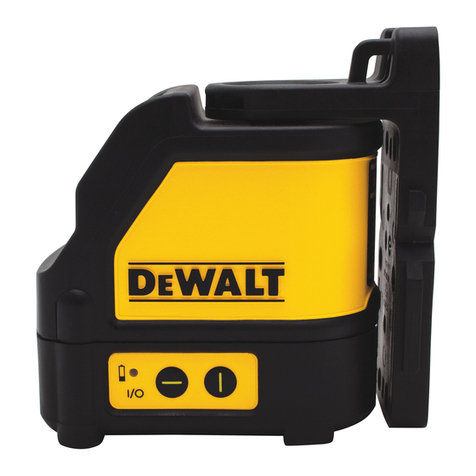
DeWalt
DeWalt LaserChalkLine DW088 Original instructions
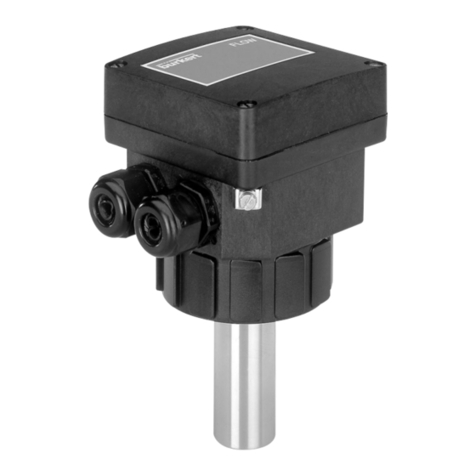
Burkert
Burkert 8041 instruction manual
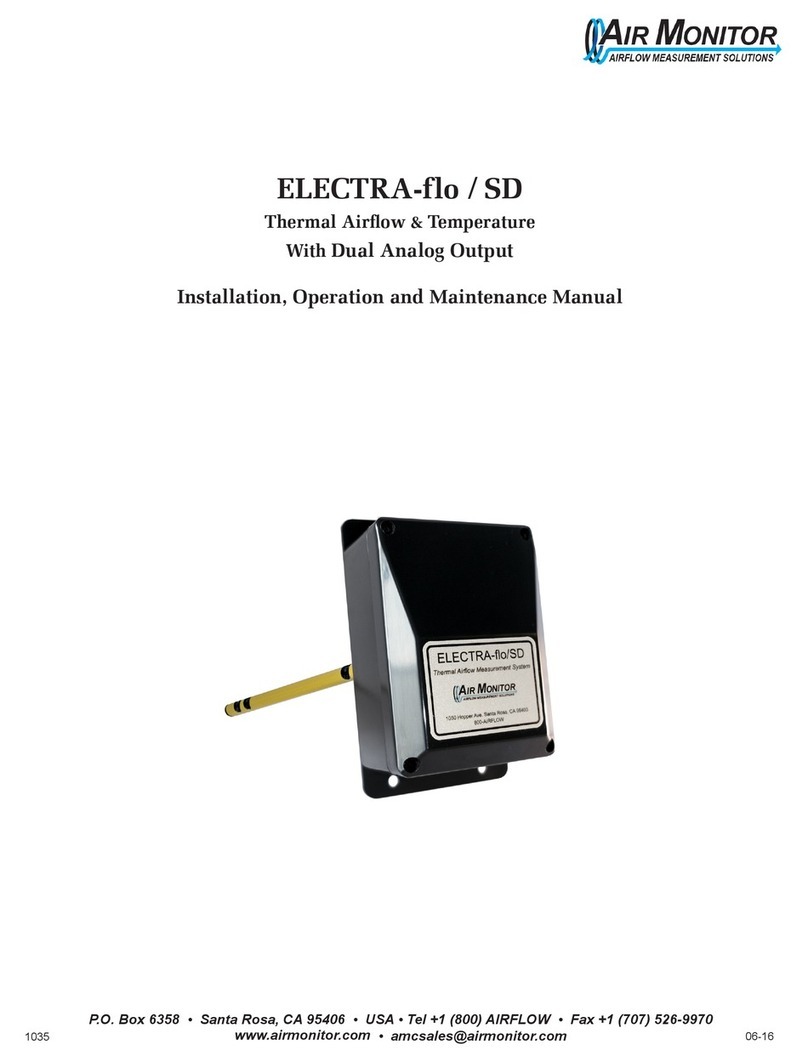
Air Monitor
Air Monitor ELECTRA-flo / SD Installation, operation and maintenance manual
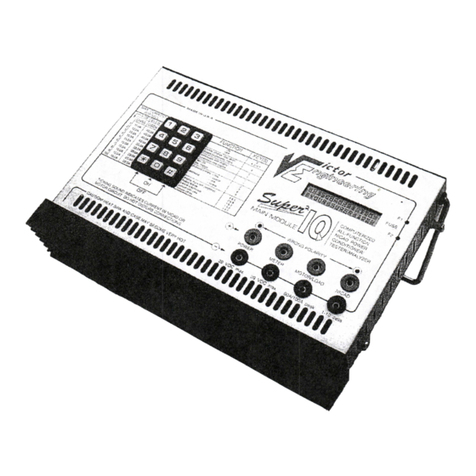
Victor Engineering
Victor Engineering Super 2 IQ/I manual

Ecolab
Ecolab SENSOPART FT 10 operating instructions
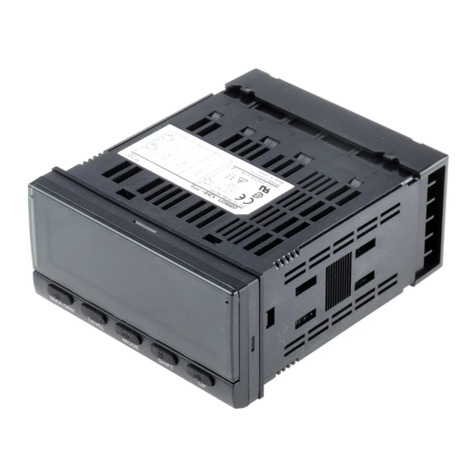
Omron
Omron K3HB-PPB Technical communications user's manual
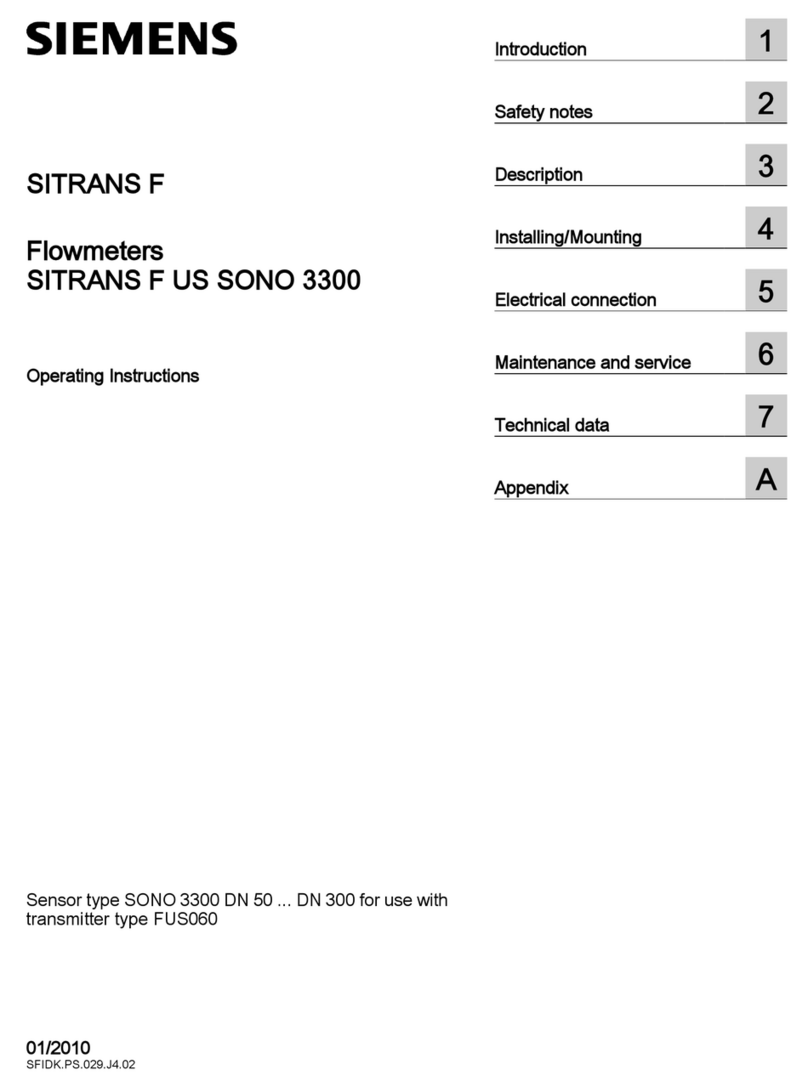
Siemens
Siemens Sitrans F Series operating instructions
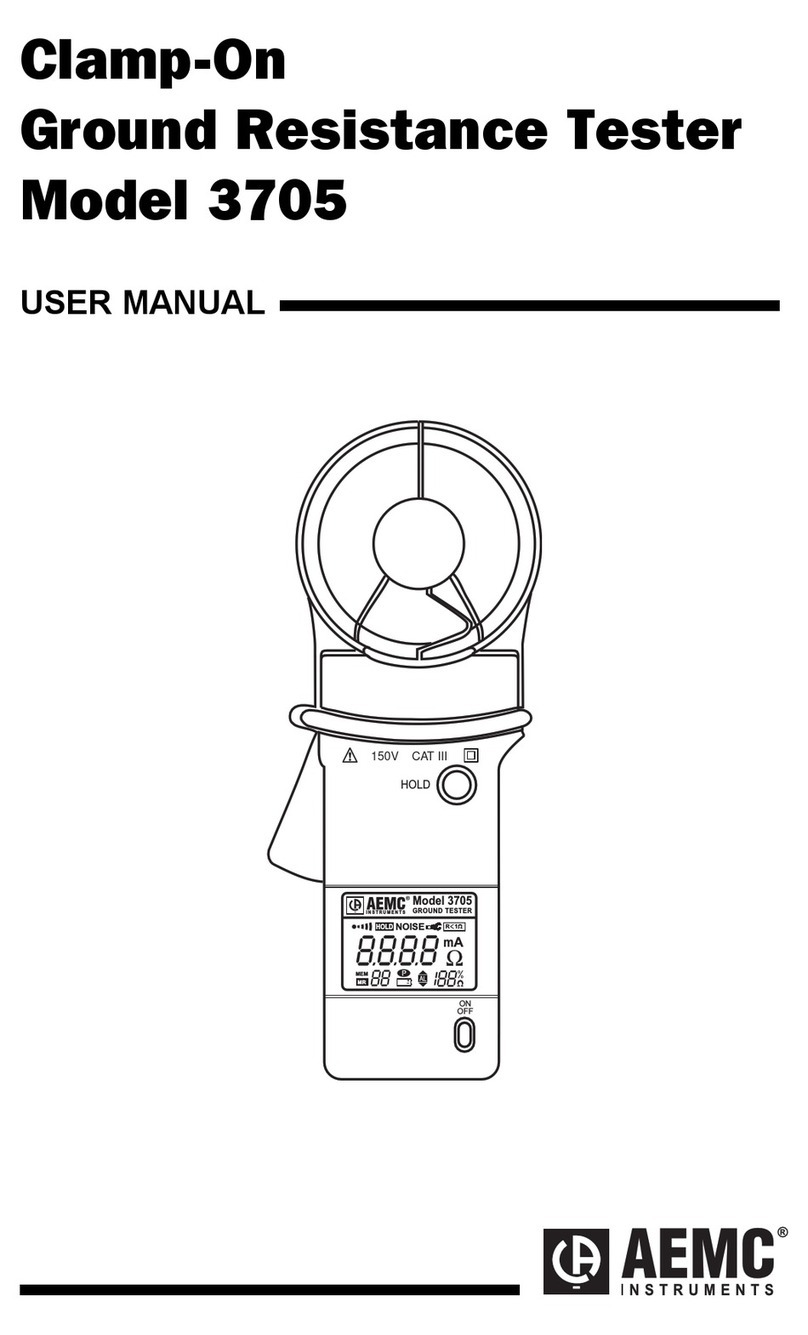
AEMC instruments
AEMC instruments Clamp-On 3705 user manual
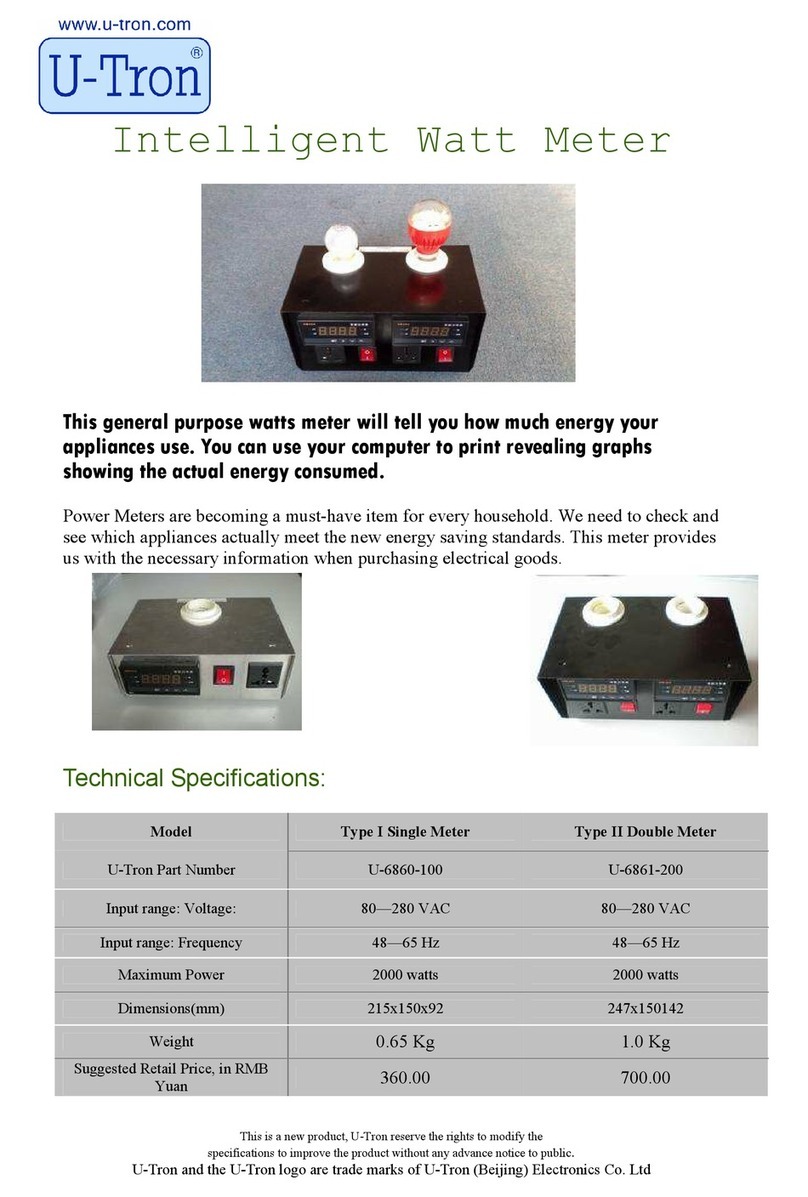
U-Tron
U-Tron U-6860-100 manual
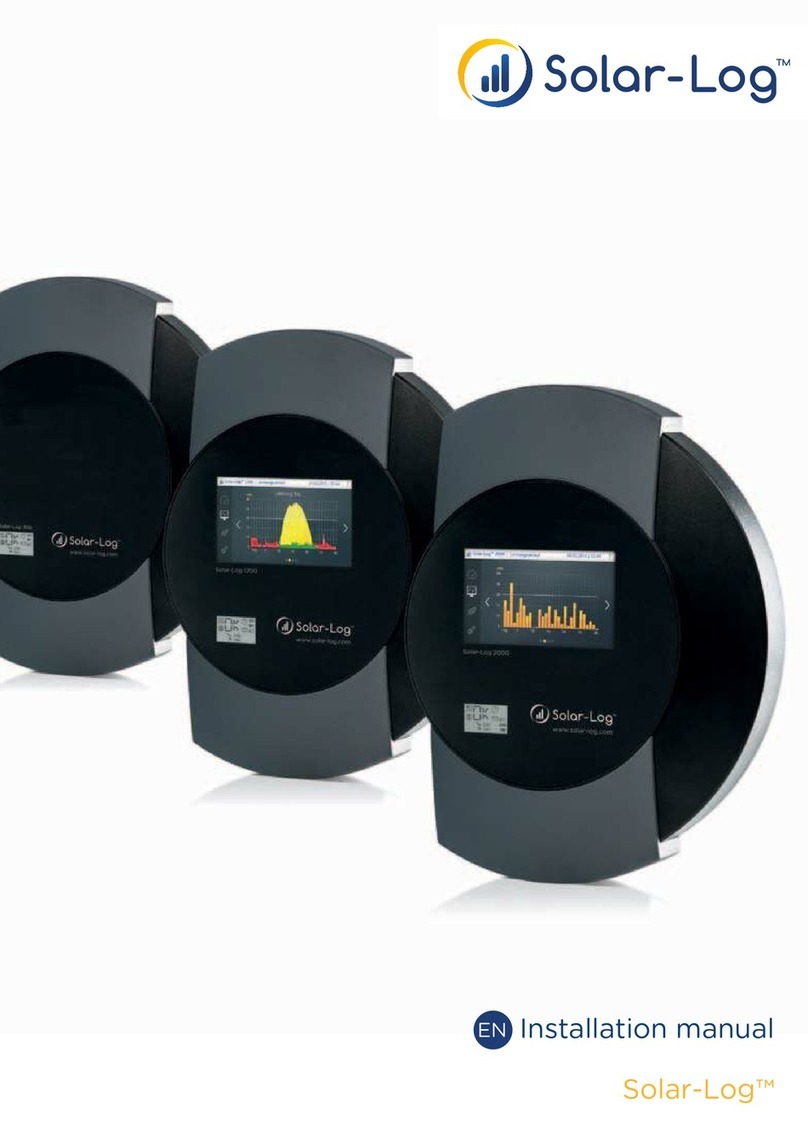
Solare Datensysteme
Solare Datensysteme Solar-Log 200 installation manual
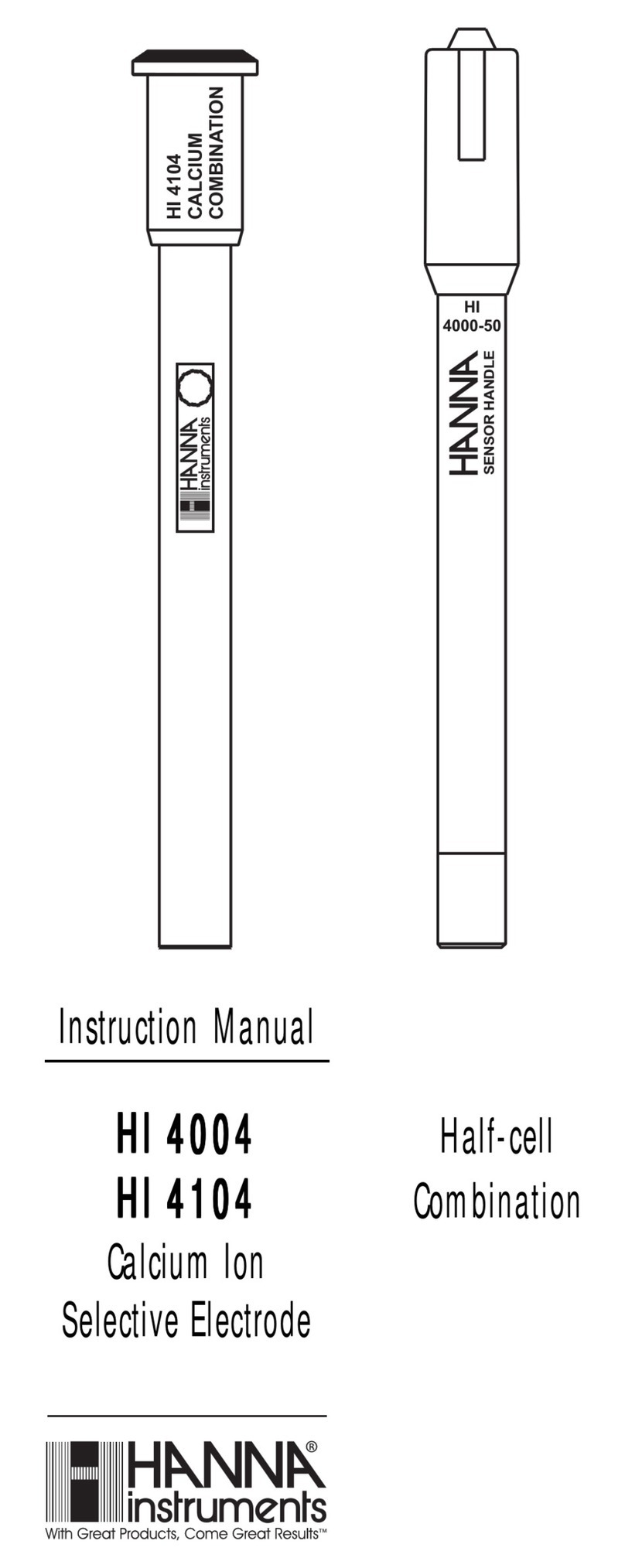
Hanna Instruments
Hanna Instruments HI 4104 instruction manual
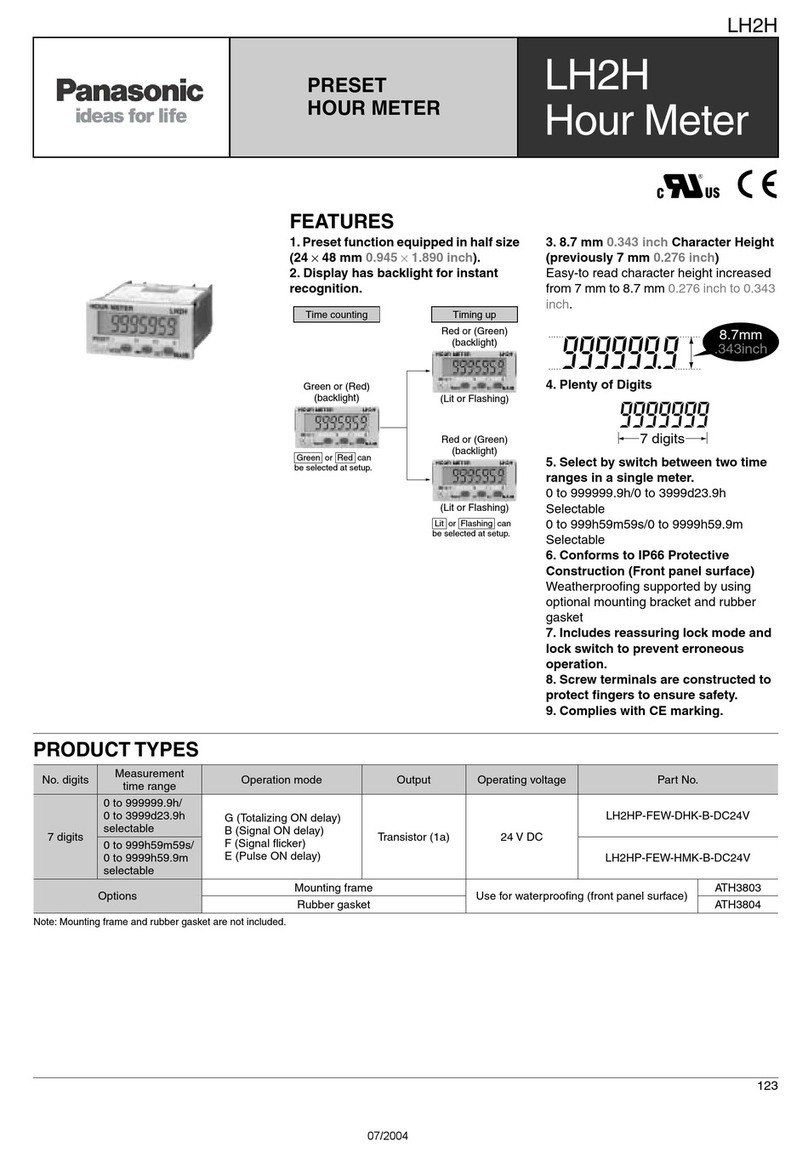
Panasonic
Panasonic LH2H preset manual
